
Retirement in Alaska might sound like a dream of snow-dusted serenity and scenic solitude—but not every town in the Last Frontier is ideal for your golden years. Based on the 2025 Overall Retirement Score (ORS), a surprising number of Alaskan communities fall short on factors like healthcare access, walkability, amenities, and ease of living.
This list highlights 18 towns with the lowest ORS in the state. While each place has its own character and strengths, retirees are moving away—or avoiding them altogether—for very specific reasons. From oil hubs to remote fishing villages, these spots simply don’t offer what many older adults are seeking: convenience, connection, and comfort.
If you’re eyeing Alaska for retirement, it’s worth knowing where to think twice before settling down. These rankings aren’t about slamming small towns—they’re about giving you the data to make the best decision for your future.
18. North Pole – Limited Senior-Friendly Healthcare
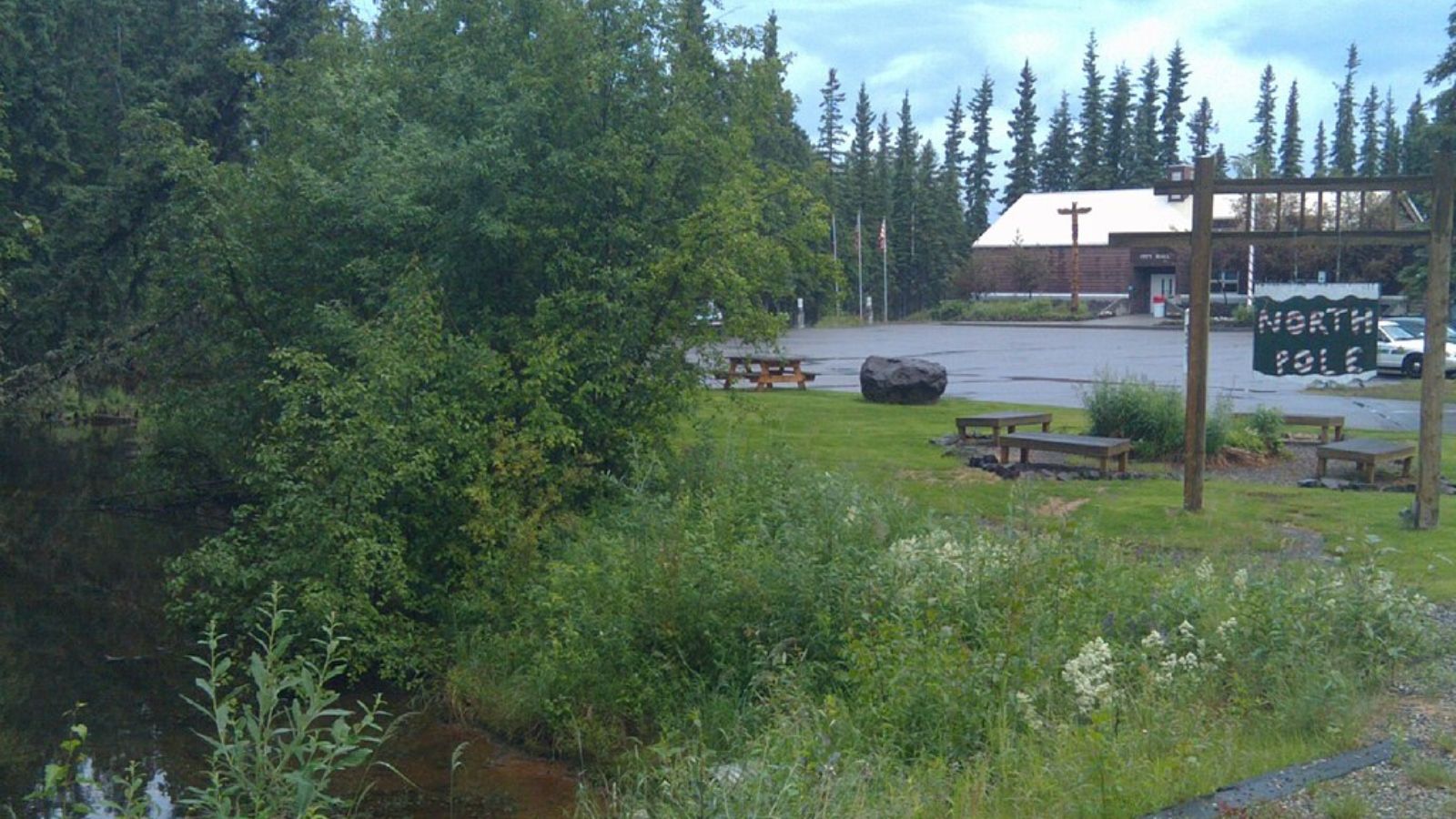
Despite its festive name and postcard charm, North Pole isn’t exactly a retirement wonderland. Located just southeast of Fairbanks, the town is better known for its Santa-themed street names and icy winters than its support for older adults. The healthcare facilities in the area are limited, and seniors may find themselves traveling into Fairbanks for routine appointments or emergencies.
While North Pole is relatively car-friendly and quiet, it lacks basic walkability and accessible amenities that retirees tend to rely on. The long, harsh winters and isolated feel may appeal to younger families or those seeking novelty, but for most retirees, the daily realities outweigh the holiday appeal.
North Pole – ORS 36.78
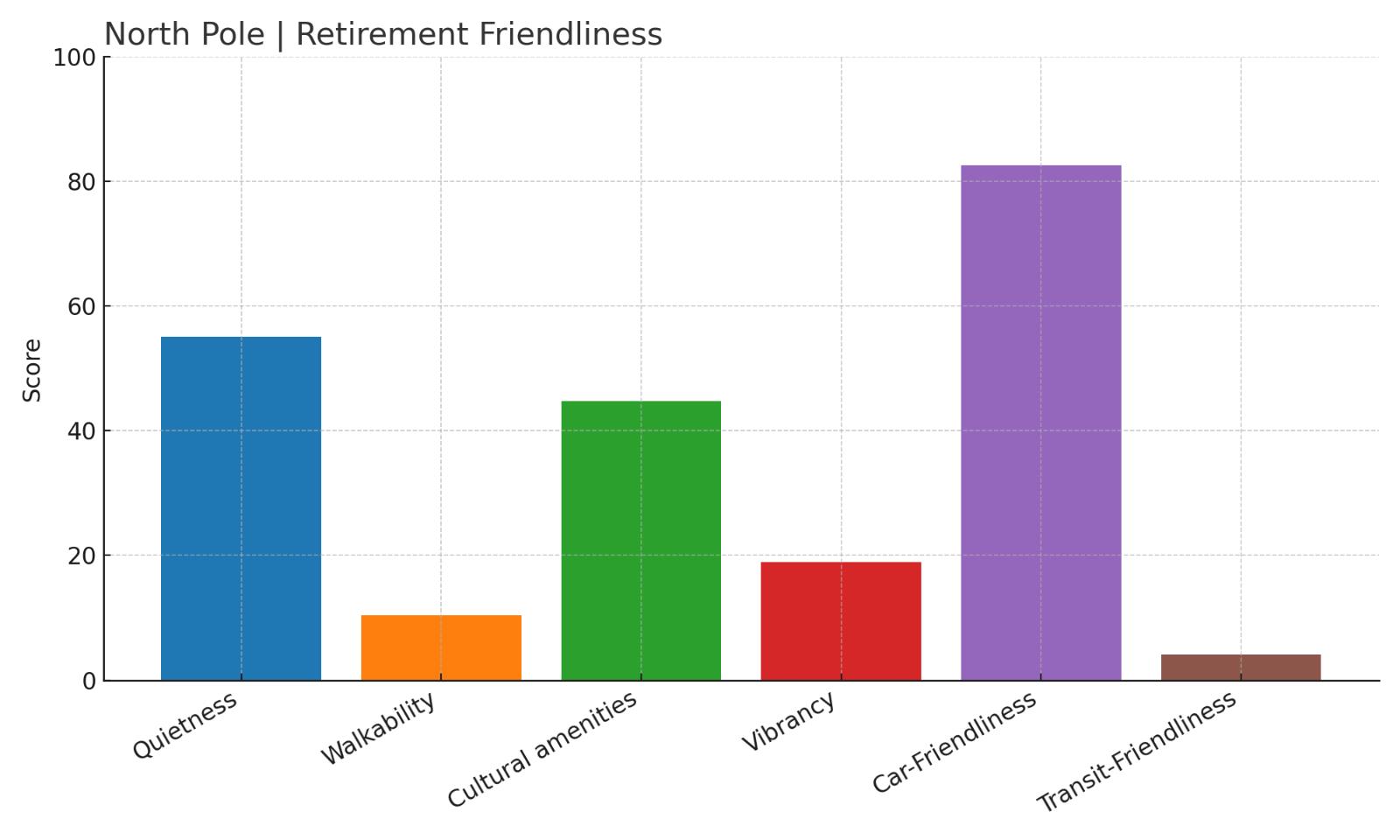
- Overall Retirement Score: 36.78
- Quietness: 55.12
- Walkability: 10.37
- Cultural amenities: 44.79
- Vibrancy: 18.93
- Car-Friendliness: 82.54
- Transit-Friendliness: 4.07
North Pole scores well on car-friendliness and has a moderate quietness rating, but its extremely low walkability and limited transit options make it hard for seniors to get around without a car. Cultural amenities are modest, but vibrancy is low, which may contribute to feelings of isolation.
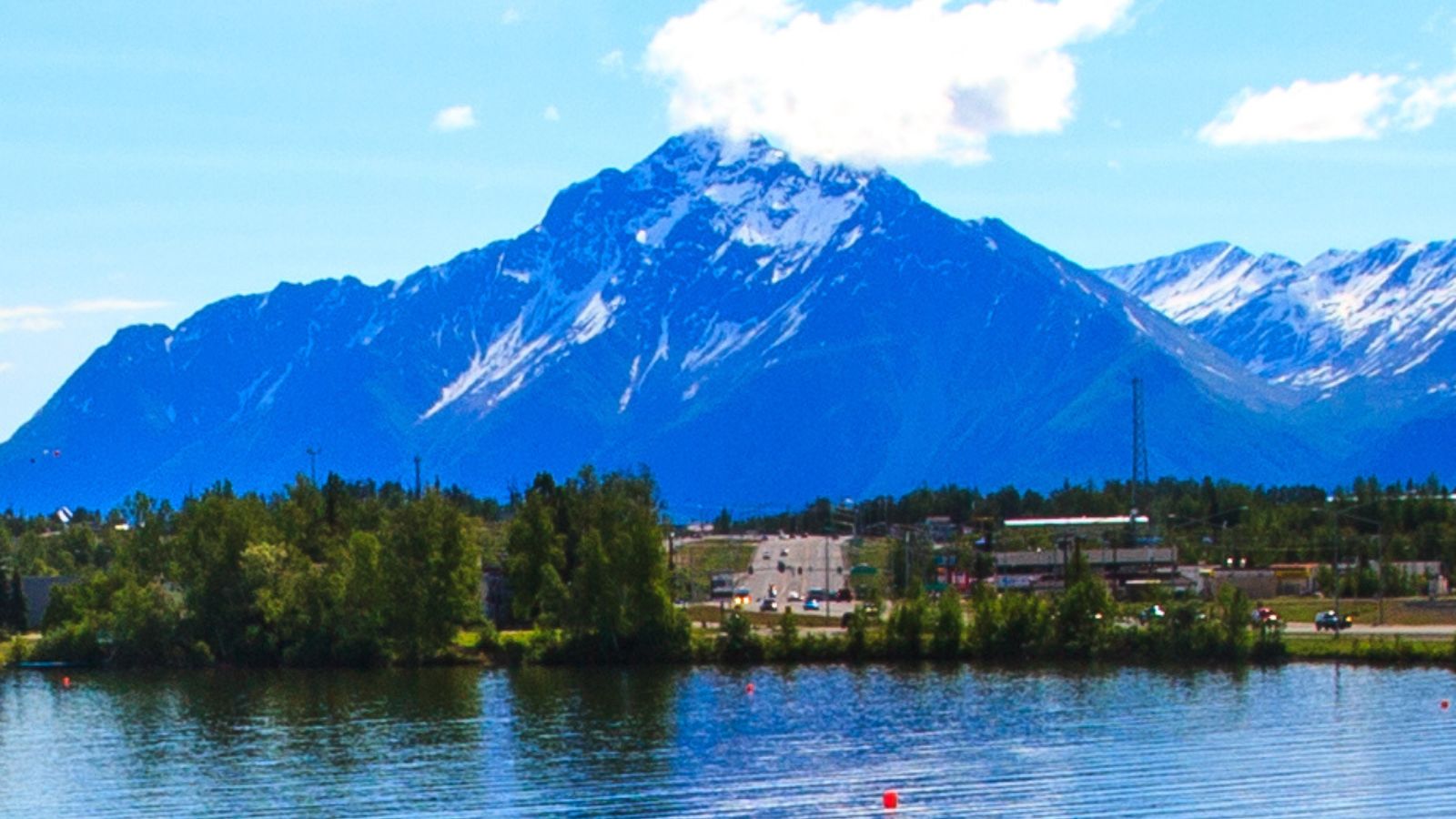
Wasilla has grown rapidly in recent decades, evolving into a busy commuter town for those working in Anchorage. But with that growth comes congestion, long drives, and a layout that doesn’t favor pedestrians. For retirees hoping to downsize their driving or enjoy walkable neighborhoods, Wasilla falls short.
Located in the Matanuska-Susitna Borough, the town has some cultural resources, but daily errands typically require a car—and even then, traffic can be a nuisance. The pace and setup make it better suited for younger residents with vehicles and active schedules, rather than seniors looking for accessibility and calm.
Wasilla – ORS 36.73
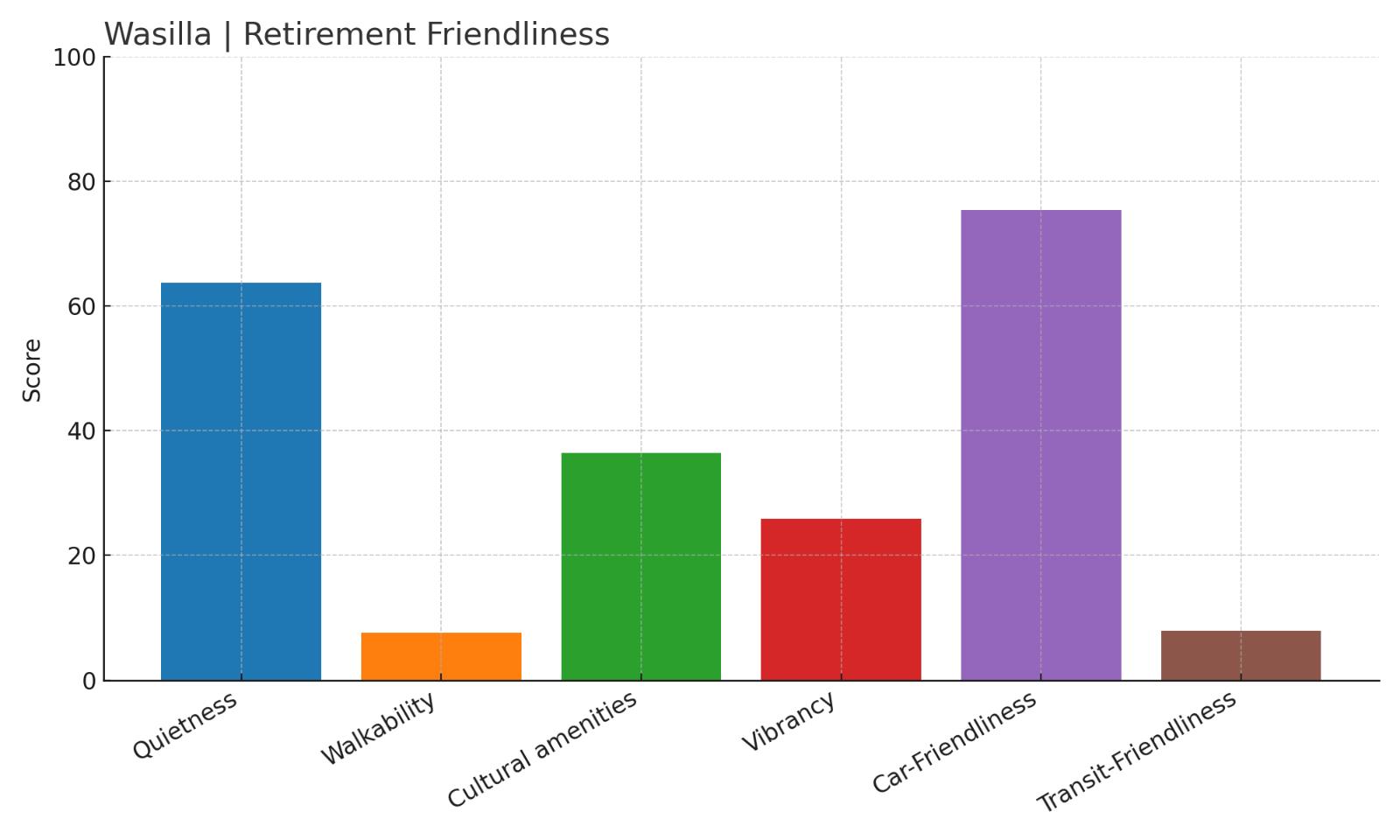
- Overall Retirement Score: 36.73
- Quietness: 63.67
- Walkability: 7.61
- Cultural amenities: 36.47
- Vibrancy: 25.91
- Car-Friendliness: 75.37
- Transit-Friendliness: 7.92
Wasilla’s low walkability and minimal transit services are big drawbacks for retirees. While it ranks decently on quietness and has some cultural amenities, the lack of easy, car-free access to services and entertainment holds it back as a retirement destination.
16. Anchorage – Crowded, Busy, and Expensive
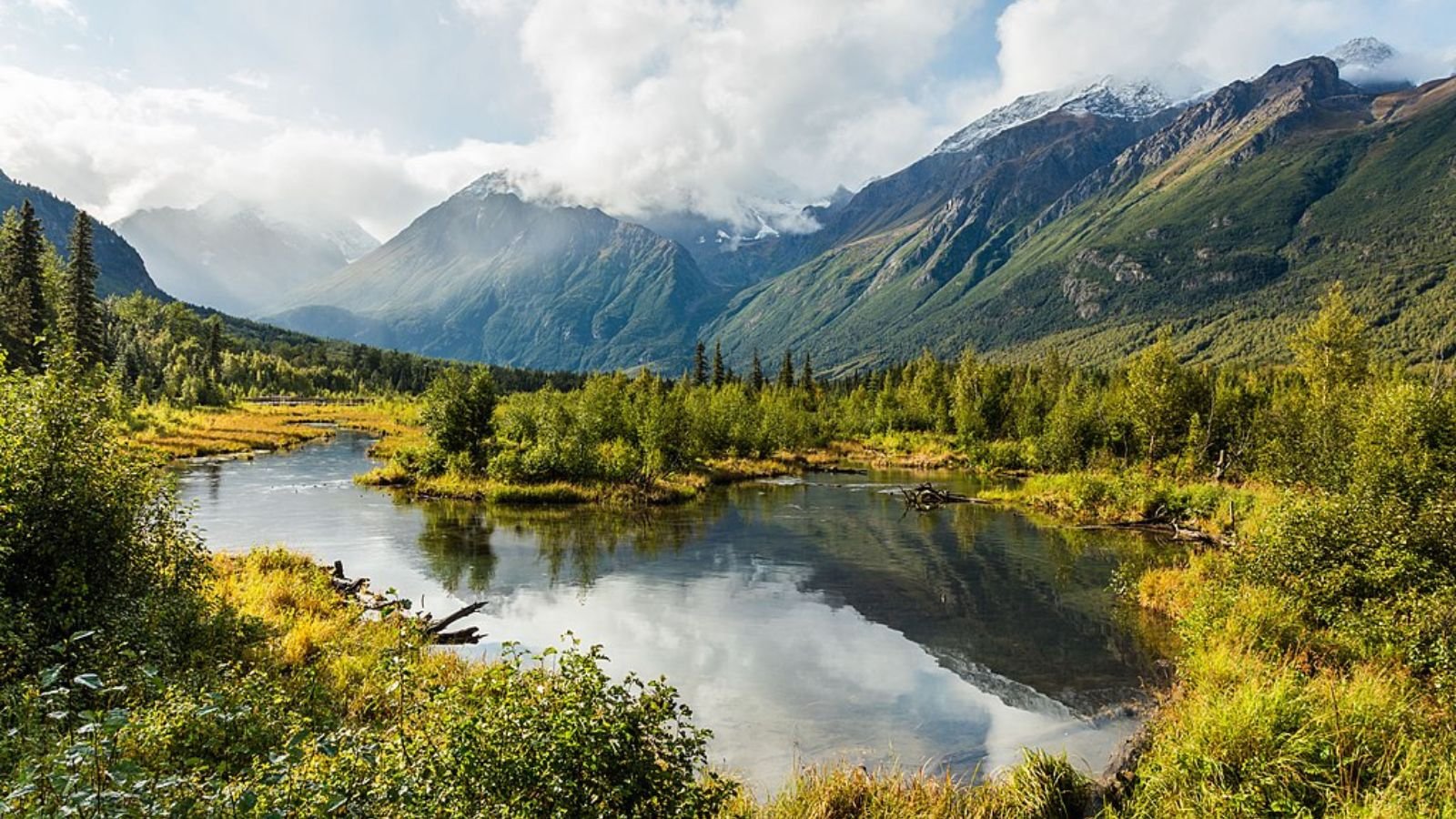
Anchorage is Alaska’s biggest city, offering the state’s best healthcare and a relatively vibrant cultural scene—but that doesn’t automatically make it senior-friendly. The city’s scale and pace can feel overwhelming, especially for those seeking peace, simplicity, or affordability in retirement.
With a mix of urban sprawl and inconsistent transit options, Anchorage often requires a car even within city limits. It’s also one of the more expensive places to live in the state, which may not align with fixed retirement budgets. While some retirees may appreciate its convenience, many are heading elsewhere for a slower, quieter lifestyle.
Anchorage – ORS 35.82
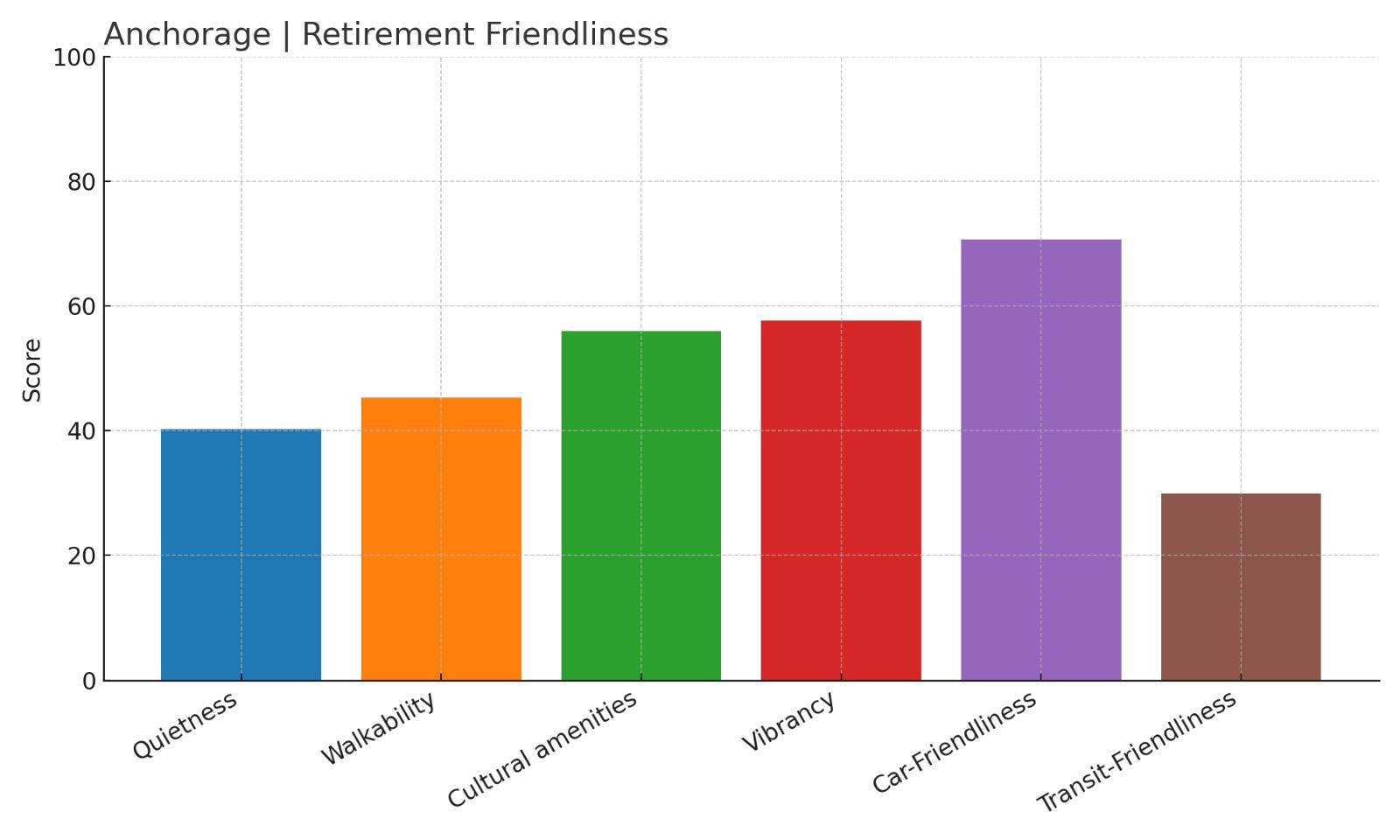
- Overall Retirement Score: 35.82
- Quietness: 40.31
- Walkability: 45.36
- Cultural amenities: 55.97
- Vibrancy: 57.62
- Car-Friendliness: 70.65
- Transit-Friendliness: 29.9
Anchorage performs well in terms of cultural amenities and vibrancy but lags when it comes to quietness and affordability. It’s walkable in parts, yet many areas still require a car. For retirees prioritizing calm, low-maintenance living, Anchorage may feel too hectic and demanding.
15. Fort Yukon – Central – Remote and Resource-Limited
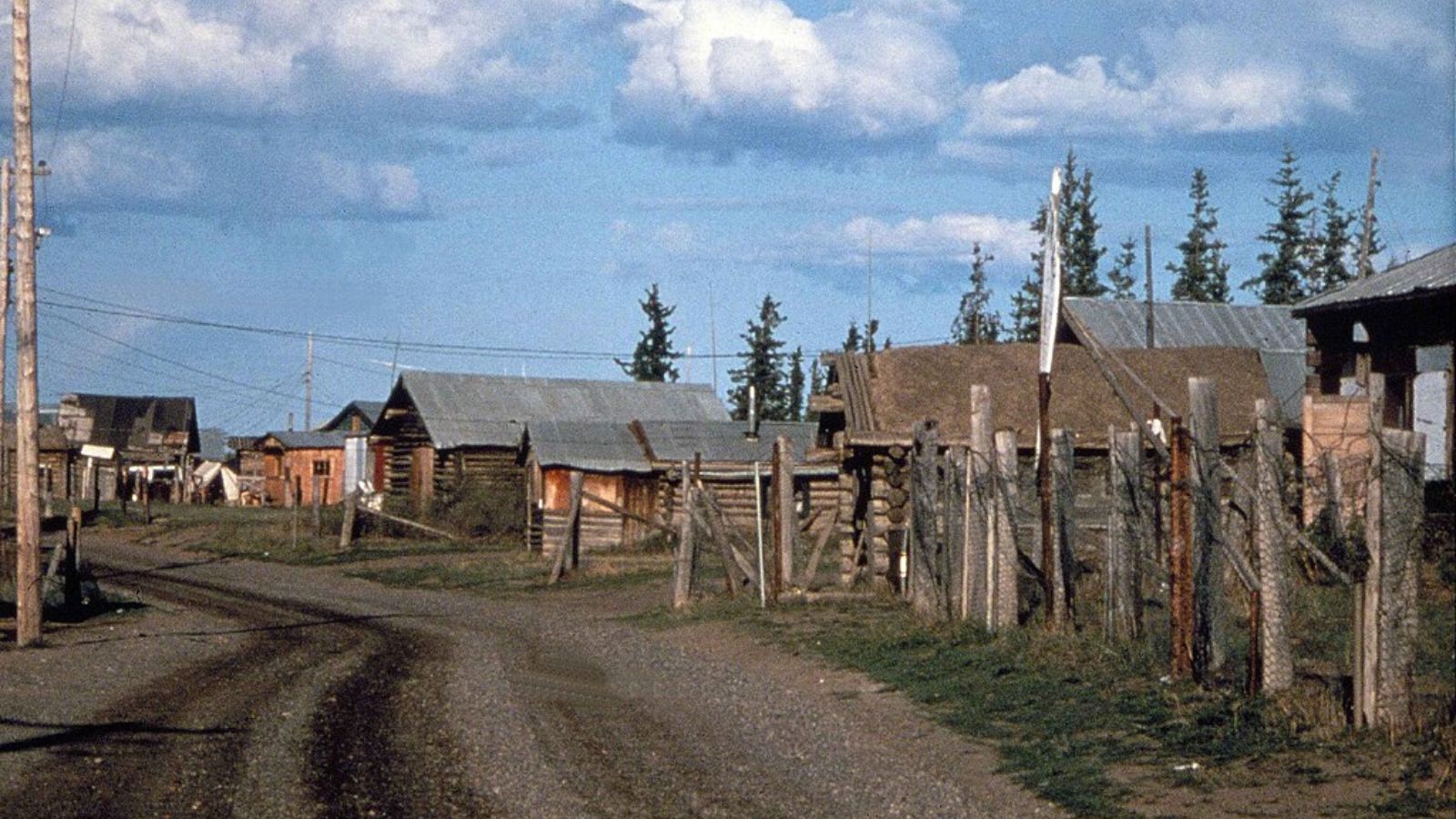
Fort Yukon is located north of the Arctic Circle and serves as a hub for several small villages in the Yukon Flats. Life here is truly remote. That isolation comes with trade-offs, especially for retirees: healthcare access is limited, goods are expensive due to transport costs, and services are few and far between.
The town is rich in Native heritage and offers beautiful views of untouched wilderness. But daily life for seniors can be difficult without strong community support systems and basic amenities. Fort Yukon is better suited for those with deep family ties to the region or a strong desire for solitude.
Fort Yukon – Central – ORS 34.24
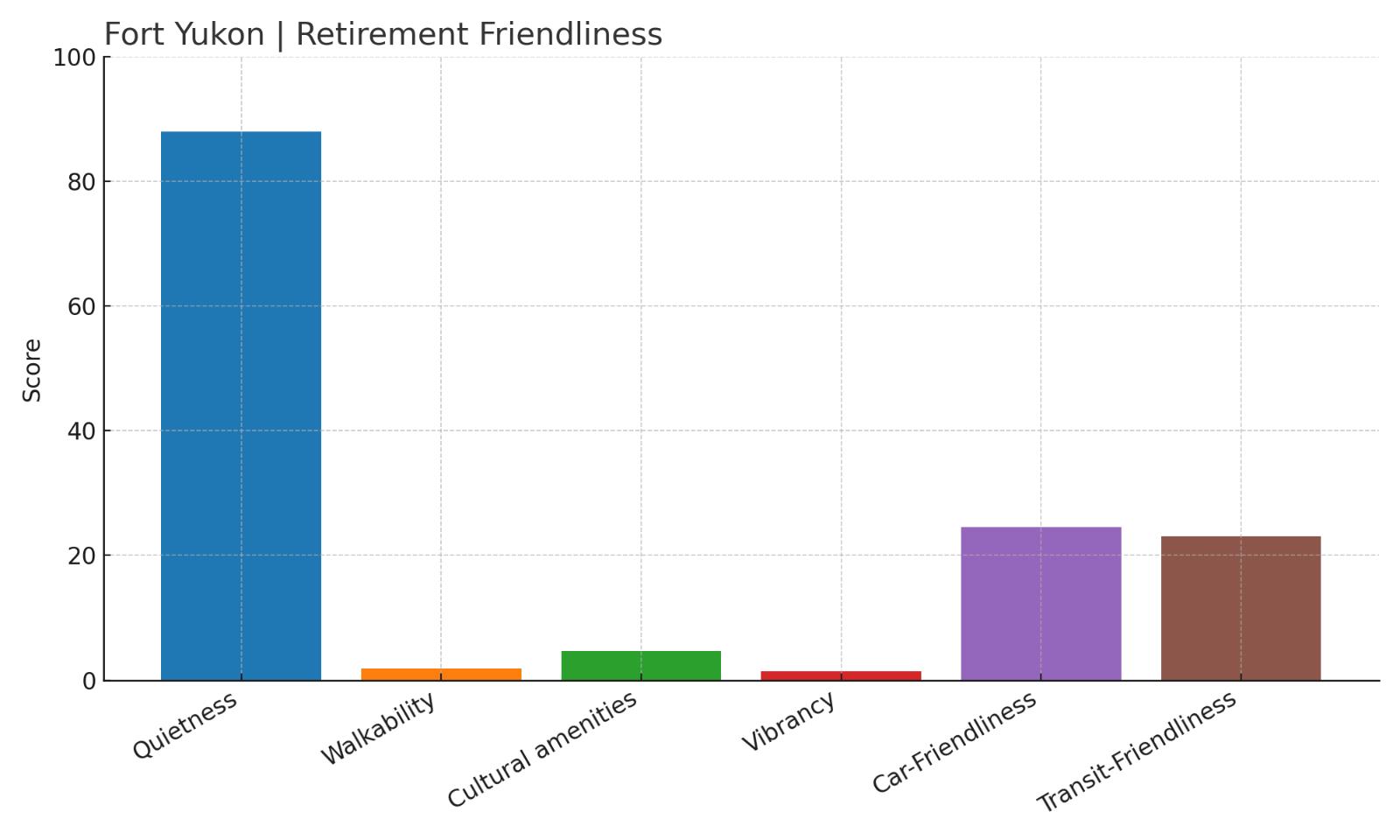
- Overall Retirement Score: 34.24
- Quietness: 87.98
- Walkability: 1.89
- Cultural amenities: 4.71
- Vibrancy: 1.4
- Car-Friendliness: 24.59
- Transit-Friendliness: 23.07
While Fort Yukon is among the quietest towns on this list, it lacks nearly every convenience retirees typically value. Walkability and cultural activities are almost nonexistent, and limited infrastructure makes daily life a challenge. Its low ORS reflects how difficult it can be to age comfortably here.
14. Prudhoe Bay – Built for Oil, Not Retirement

Prudhoe Bay is an industrial center built around Alaska’s oil production—not exactly a place designed with retirees in mind. Located in the far north, this area sees extreme weather, minimal sunlight in winter, and a landscape dominated by pipelines and worker housing.
There’s no traditional town center, and most amenities cater to a temporary workforce rather than long-term residents. Seniors would likely struggle with isolation, lack of healthcare options, and nearly nonexistent walkability. It’s a functional region—but not a livable one for retirement.
Prudhoe Bay – ORS 32.37
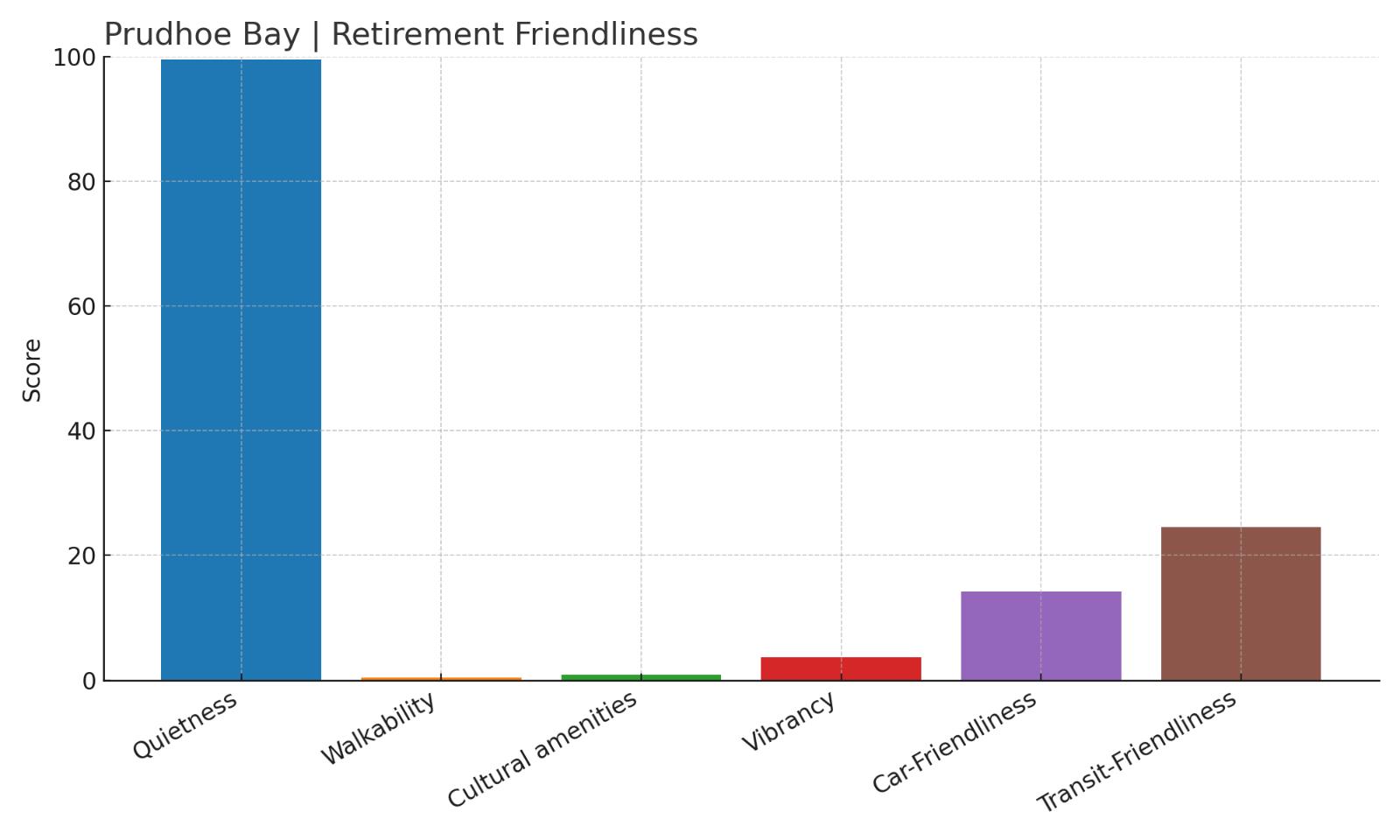
- Overall Retirement Score: 32.37
- Quietness: 99.47
- Walkability: 0.4
- Cultural amenities: 0.87
- Vibrancy: 3.68
- Car-Friendliness: 14.22
- Transit-Friendliness: 24.55
Prudhoe Bay is exceptionally quiet, but that’s where the advantages end. The area has virtually no walkability, few cultural or community offerings, and a layout that doesn’t support a typical residential lifestyle. It ranks poorly across almost every retiree-friendly metric.
13. Bethel – Isolation and Harsh Conditions
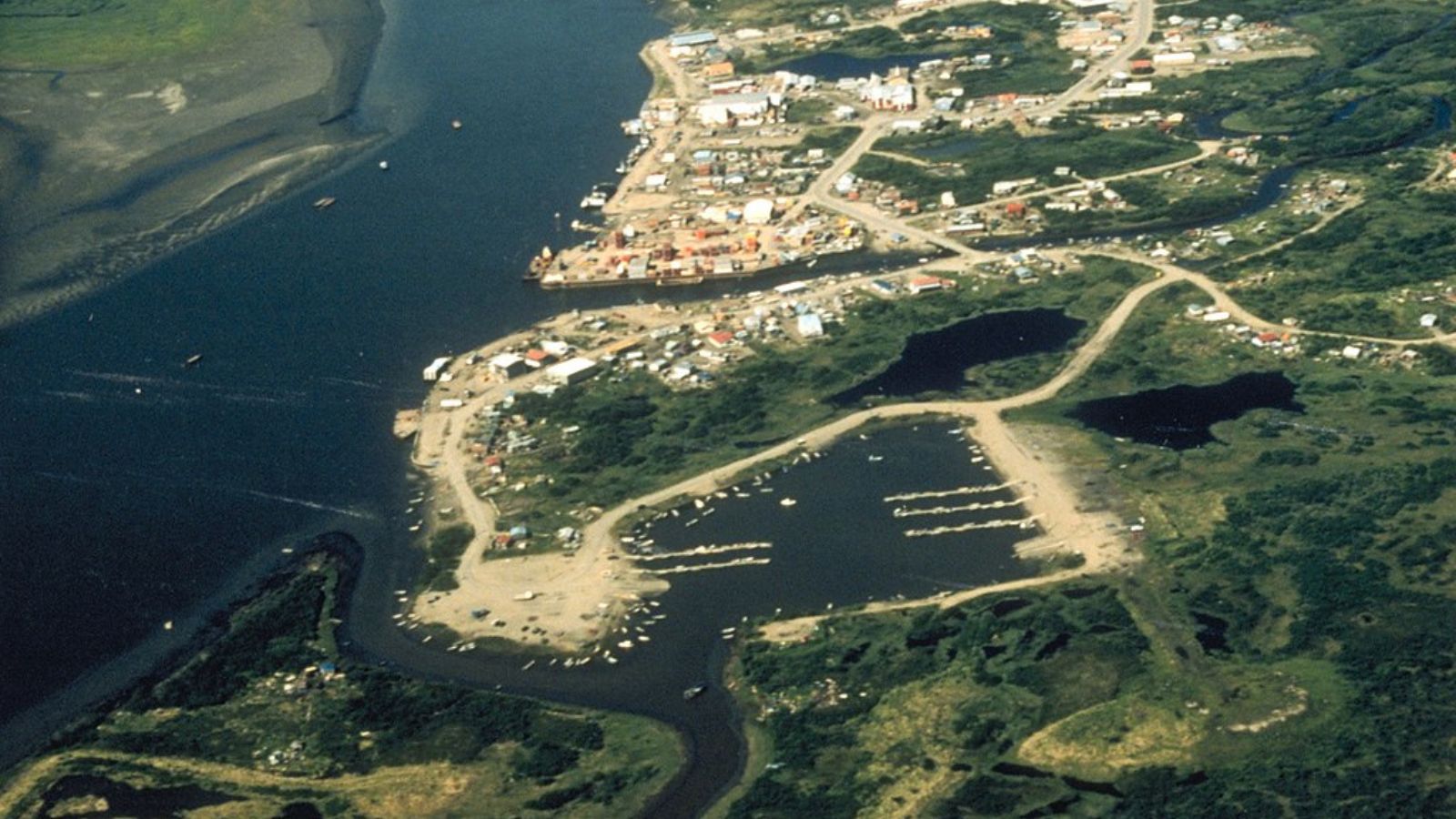
Bethel is a regional hub in western Alaska, reachable mainly by plane or boat. While it serves several nearby villages, it remains physically isolated from the rest of the state—there are no connecting roads to Anchorage or Fairbanks. For retirees, that can mean significant barriers to healthcare, travel, and social opportunities.
The community has deep cultural roots and plays an important role in rural Alaska, but everyday conveniences are scarce. Combined with extremely limited walkability and no public transit, seniors here may face challenges simply getting groceries or visiting a doctor. The cost of living is high, and infrastructure is minimal.
Bethel – ORS 32.36
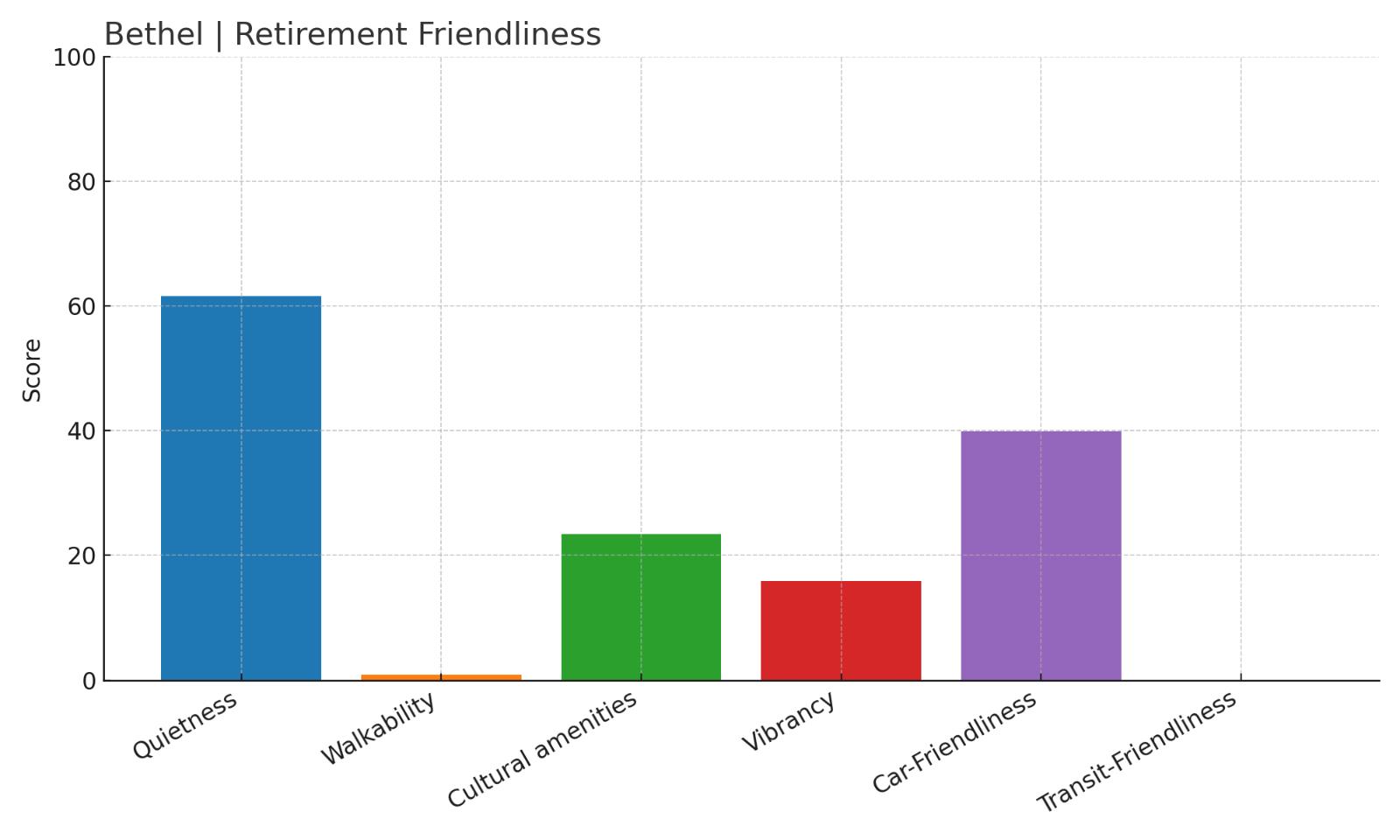
- Overall Retirement Score: 32.36
- Quietness: 61.56
- Walkability: 0.9
- Cultural amenities: 23.46
- Vibrancy: 15.87
- Car-Friendliness: 39.88
- Transit-Friendliness: 0
Bethel offers some cultural amenities and moderate quietness, but the near-total lack of transit and walkability drags down its appeal for retirees. Without a car, getting around is tough—and even with one, the area’s limited roadways and remote setting create major lifestyle obstacles.
12. Unalaska – Scenic but Inaccessible
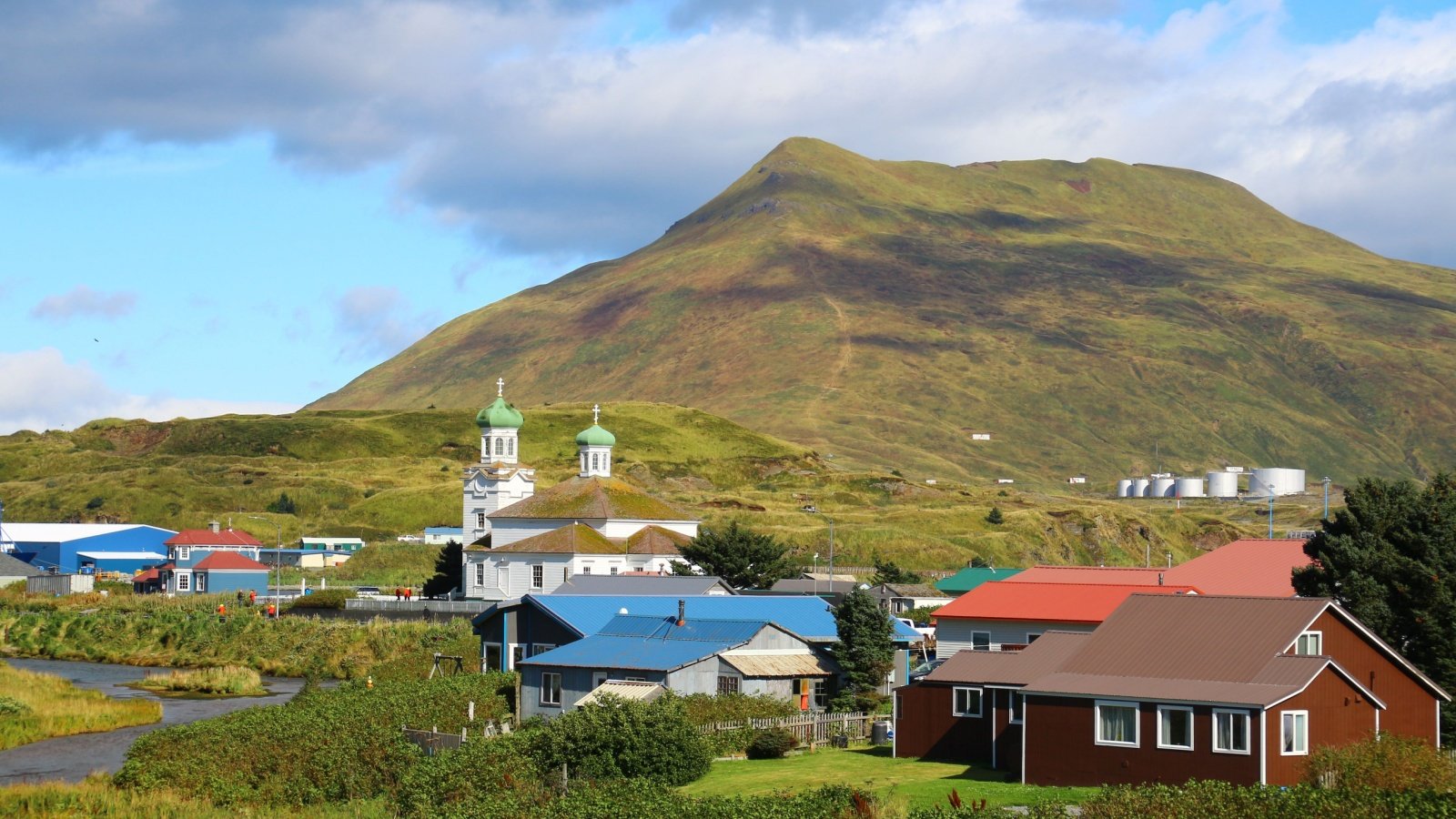
Best known as the main city on the Aleutian island of the same name, Unalaska is physically stunning and rich in fishing history—but it’s also incredibly hard to reach. With no road access to mainland Alaska, it’s accessible only by boat or plane. That’s a serious drawback for retirees who need reliable access to services or family.
The town does offer some community resources, but daily life can feel restricted. Groceries, fuel, and basic goods are expensive. For older adults with mobility issues or health conditions, Unalaska’s isolation can make everything from medical care to socializing more difficult.
Unalaska – ORS 30.87
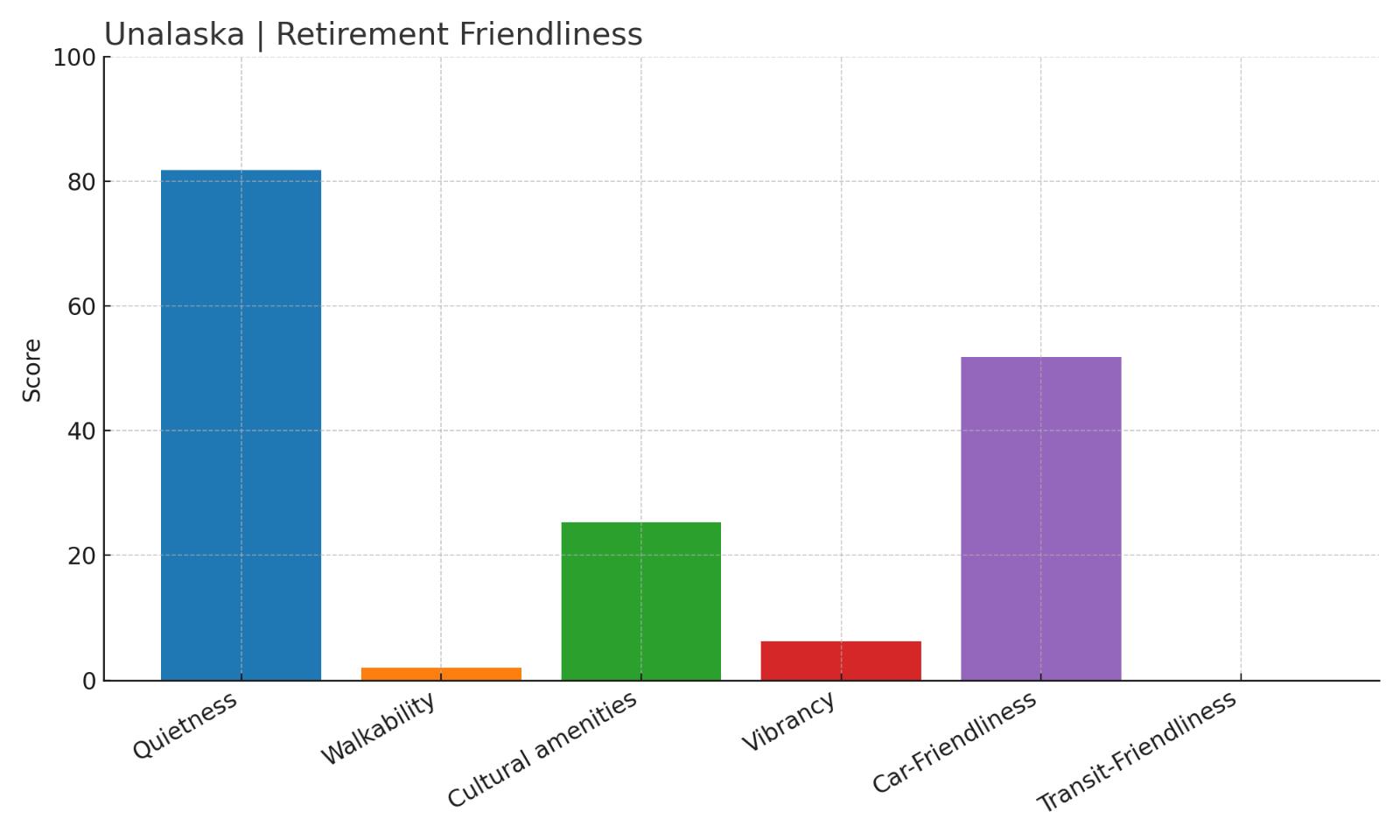
- Overall Retirement Score: 30.87
- Quietness: 81.8
- Walkability: 2.01
- Cultural amenities: 25.35
- Vibrancy: 6.27
- Car-Friendliness: 51.85
- Transit-Friendliness: 0
Unalaska offers good quietness and modest cultural options, but its abysmal walkability and total lack of transit options make it poorly suited for retirees. The town’s appeal is limited to those seeking rugged, remote living—not accessible or connected retirement living.
11. Kotzebue – Cold, Remote, and Inflexible
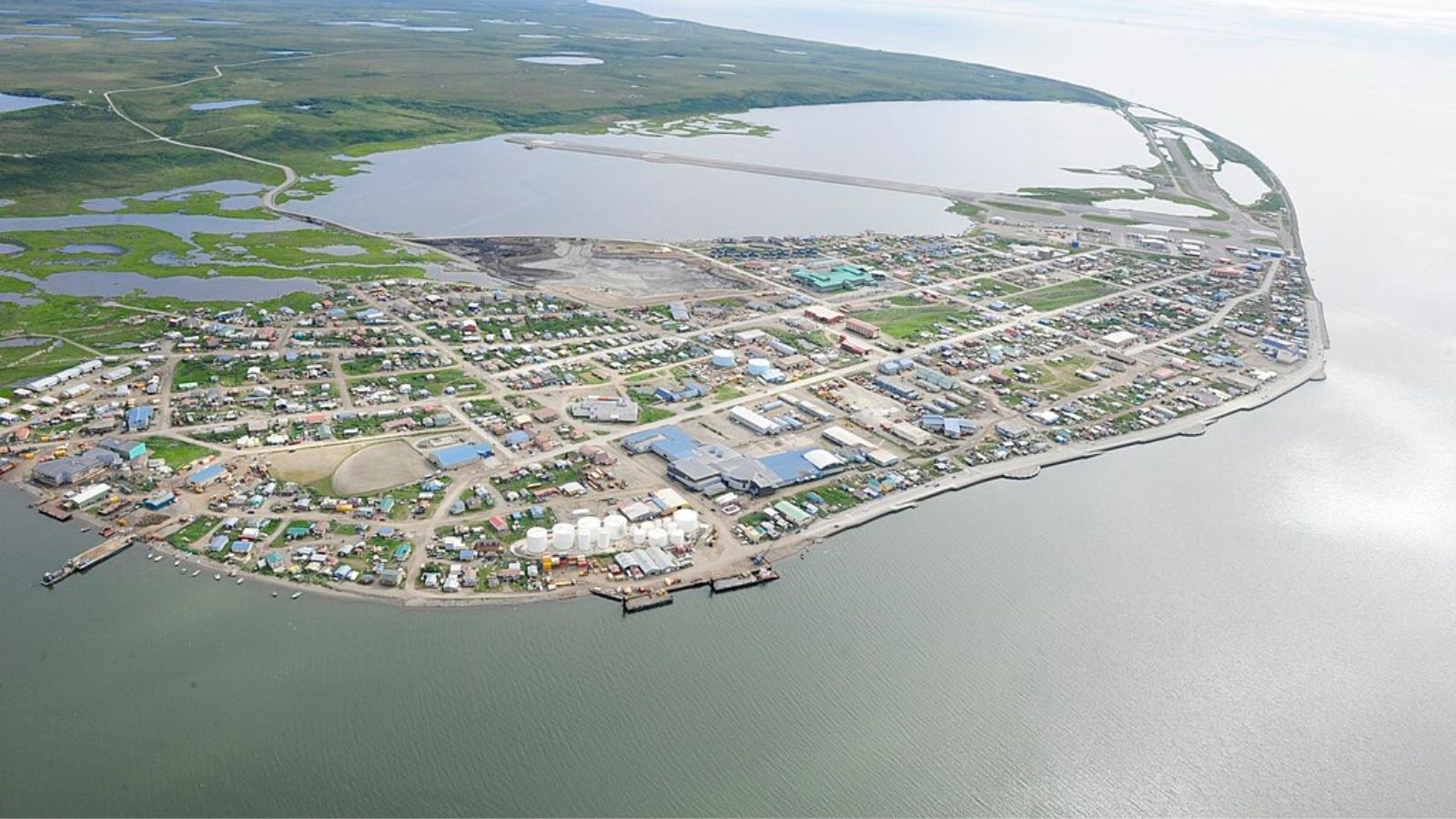
Kotzebue sits above the Arctic Circle on the shores of the Chukchi Sea, making it one of the most northern communities in Alaska. Its remote setting brings with it serious limitations—access to medical care, goods, and reliable travel is challenging year-round, and winters are long and unforgiving.
The town has a strong Indigenous community and some cultural activities, but services for seniors are minimal. With poor road infrastructure and freezing conditions, outdoor mobility can be difficult. While Kotzebue may appeal to those with local roots, most retirees would struggle to thrive here long-term.
Kotzebue – ORS 29.25
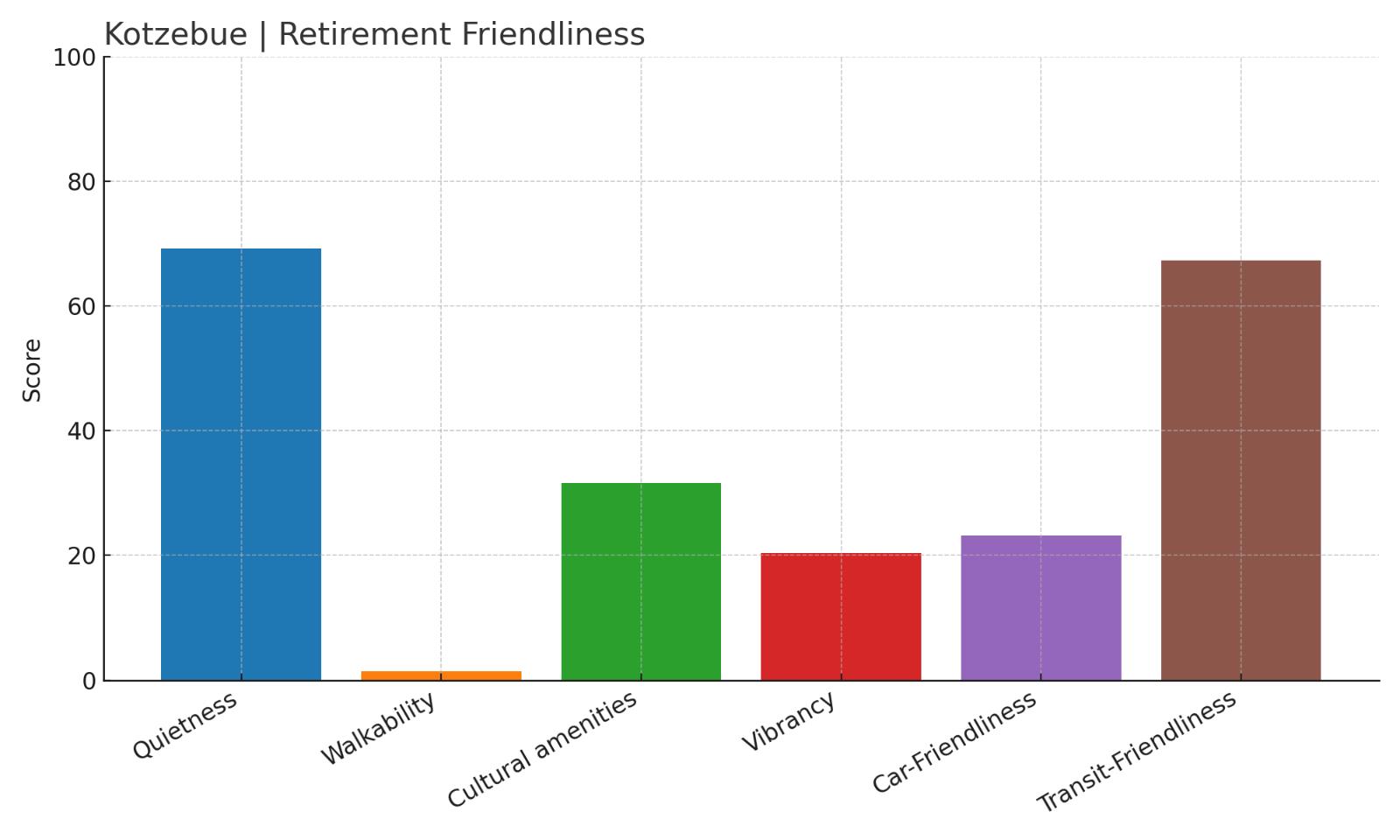
- Overall Retirement Score: 29.25
- Quietness: 69.19
- Walkability: 1.41
- Cultural amenities: 31.56
- Vibrancy: 20.38
- Car-Friendliness: 23.15
- Transit-Friendliness: 67.35
Kotzebue scores well for transit-friendliness by rural standards, but extremely poor walkability and car infrastructure hold it back. While it has a few cultural highlights, the overall setup makes life complicated for retirees looking for ease, comfort, and medical access.
10. Hooper Bay – Chevak – Lacking Services and Connectivity
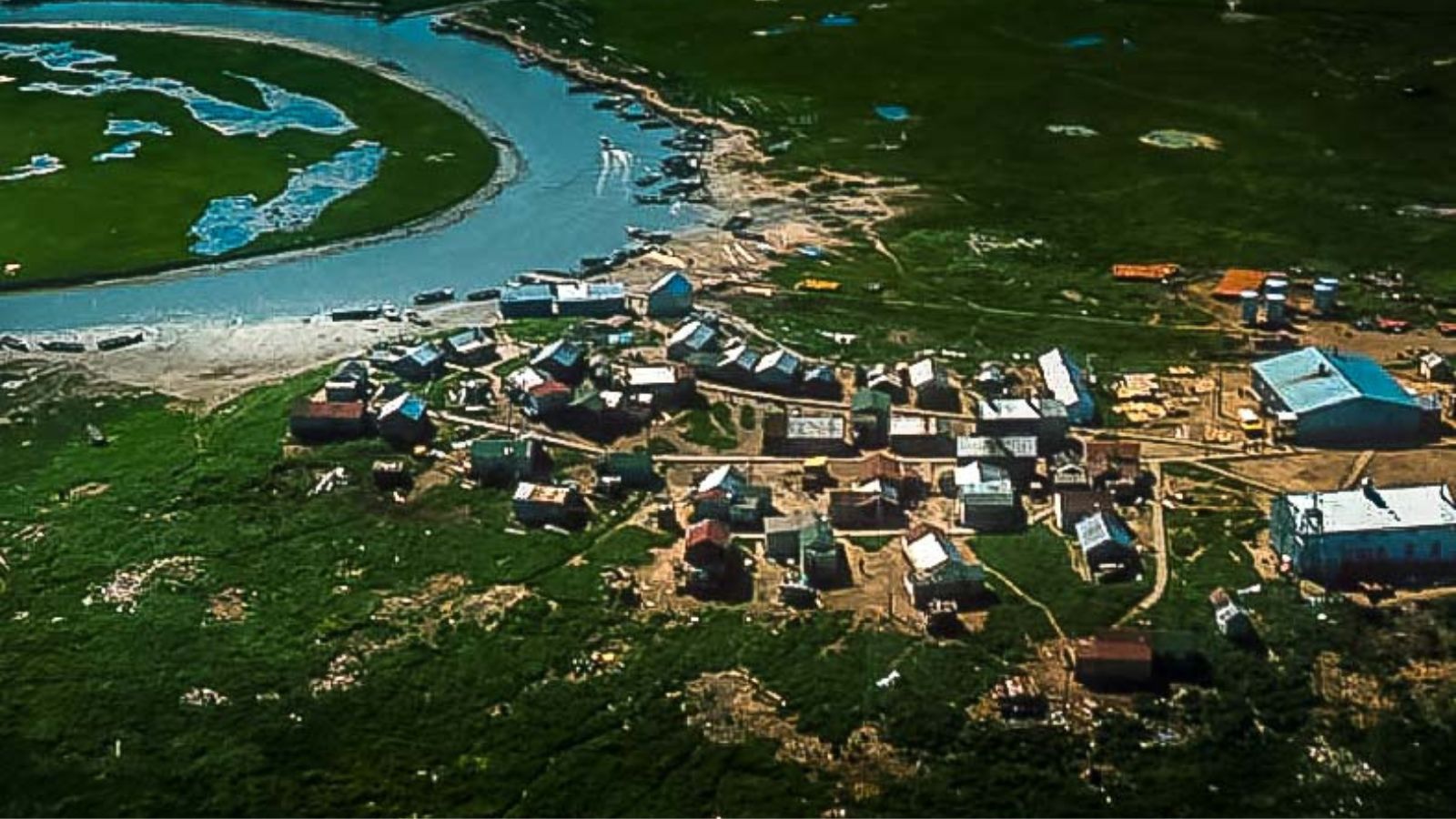
Hooper Bay and nearby Chevak are coastal communities in western Alaska that are among the most remote in the state. The area has a deep Indigenous heritage, but limited public infrastructure and few senior-specific services. Access to groceries, healthcare, or even basic shopping often requires a plane trip.
The natural quiet is appealing, but the towns lack walkability, have zero public transit, and offer very few social or recreational outlets. For retirees not already embedded in these tight-knit communities, the lack of access and resources can lead to a sense of isolation and frustration.
Hooper Bay – Chevak – ORS 28.42
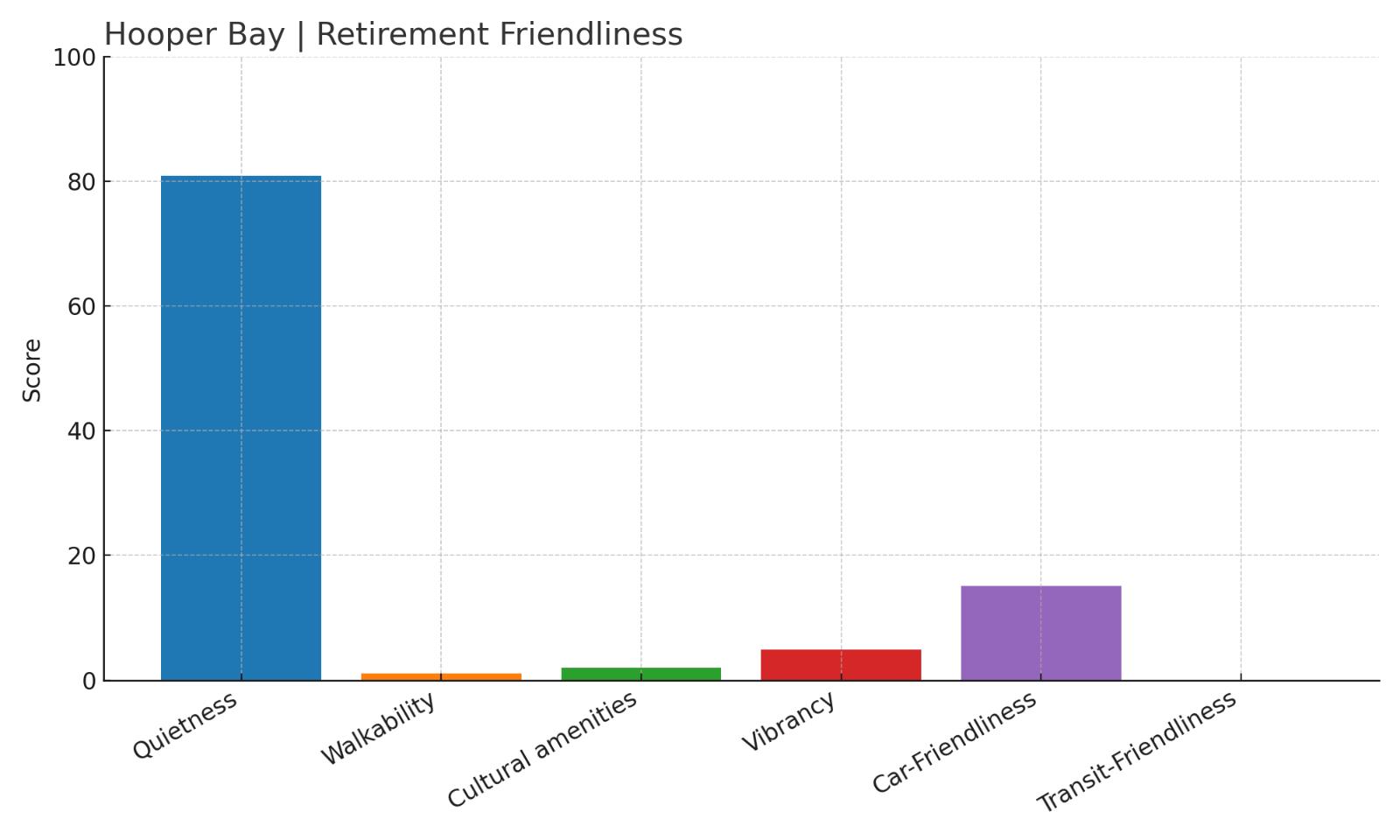
- Overall Retirement Score: 28.42
- Quietness: 80.93
- Walkability: 1.11
- Cultural amenities: 2.02
- Vibrancy: 4.87
- Car-Friendliness: 15.15
- Transit-Friendliness: 0
Hooper Bay and Chevak are peaceful, but severely lack infrastructure for older adults. Without walkable routes, cultural spaces, or transportation, basic needs become complicated. This area ranks low across nearly every retirement-relevant category, pushing it far down the list.
9. Kwethluk – Virtually No Amenities for Seniors
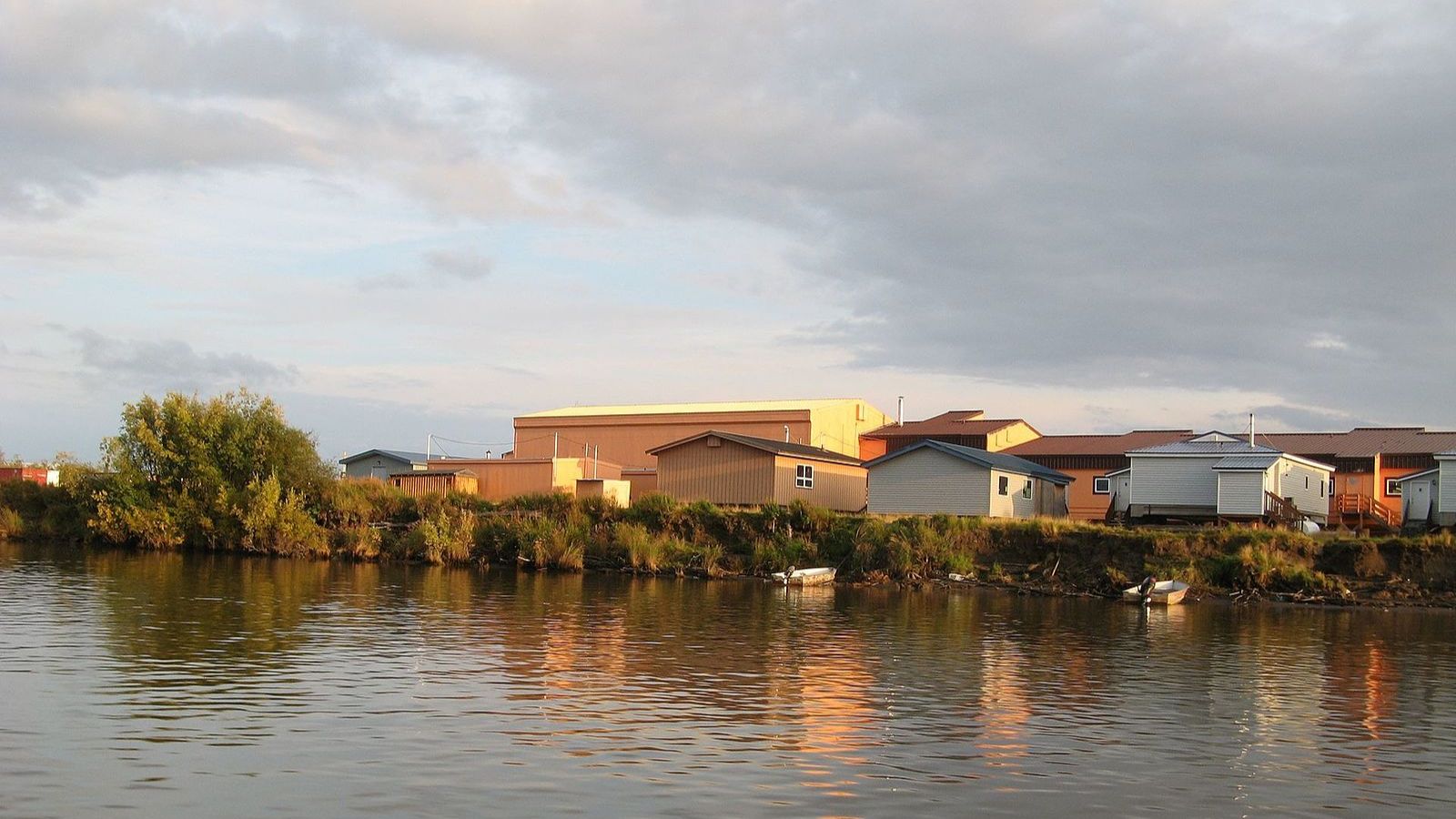
Kwethluk is a small village in the Yukon-Kuskokwim Delta, reachable only by river or air. While it’s home to a close-knit community, the village lacks almost all the features retirees typically look for: there are no walkable areas, extremely limited shopping options, and no local healthcare facilities beyond basic care.
For older adults, the absence of nearby medical specialists, grocery stores, or public transit creates major lifestyle hurdles. The rural charm may appeal to residents with strong local ties, but for most retirees, it’s simply too disconnected to support aging comfortably and independently.
Kwethluk – ORS 28.33
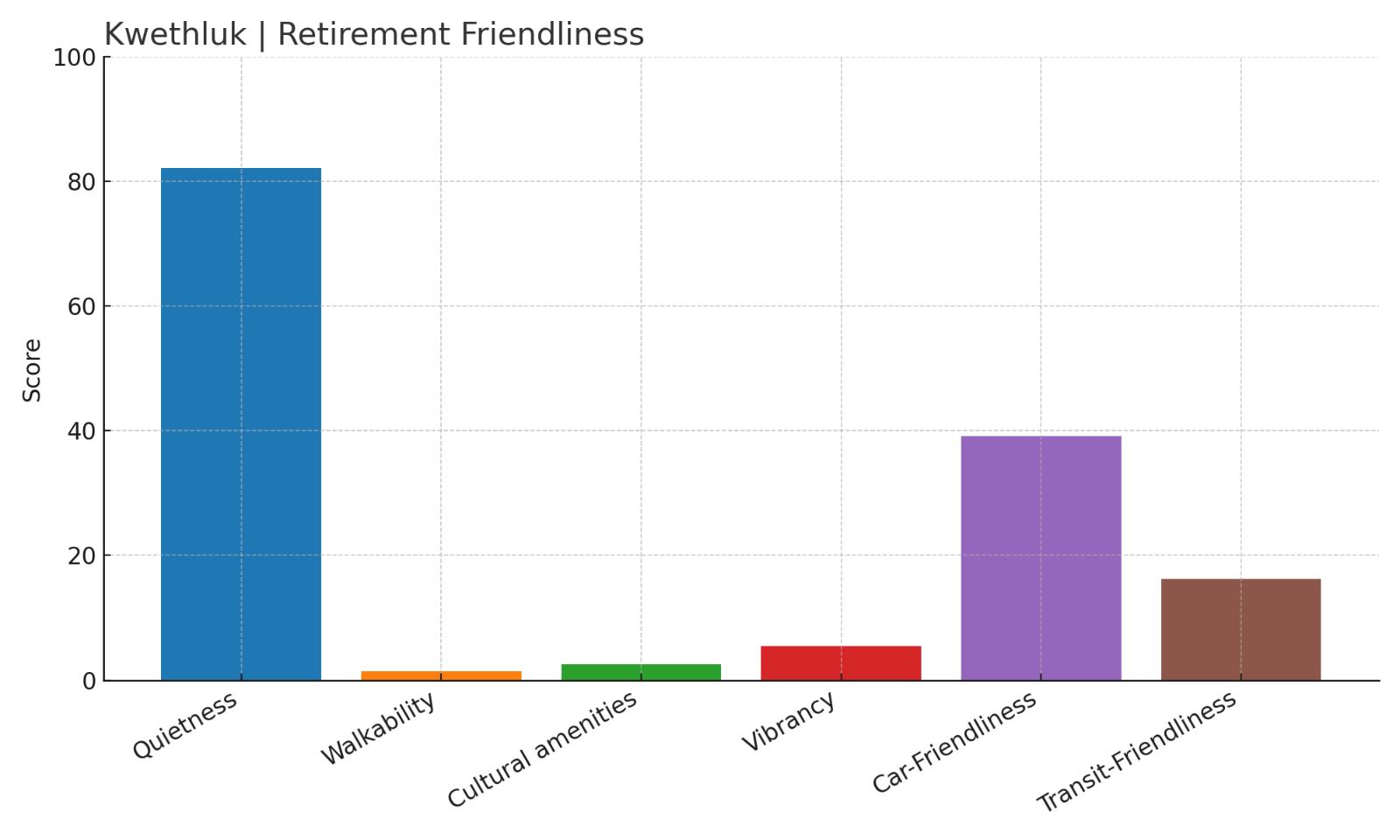
- Overall Retirement Score: 28.33
- Quietness: 82.12
- Walkability: 1.44
- Cultural amenities: 2.54
- Vibrancy: 5.51
- Car-Friendliness: 39.15
- Transit-Friendliness: 16.25
Kwethluk earns points for peace and quiet, but the overall lack of cultural amenities, transportation, and walkability severely limits its suitability for retirement. Without the basics in place, day-to-day living becomes impractical for seniors.
8. Aniak – Lower Kalskag – Isolated and Hard to Access
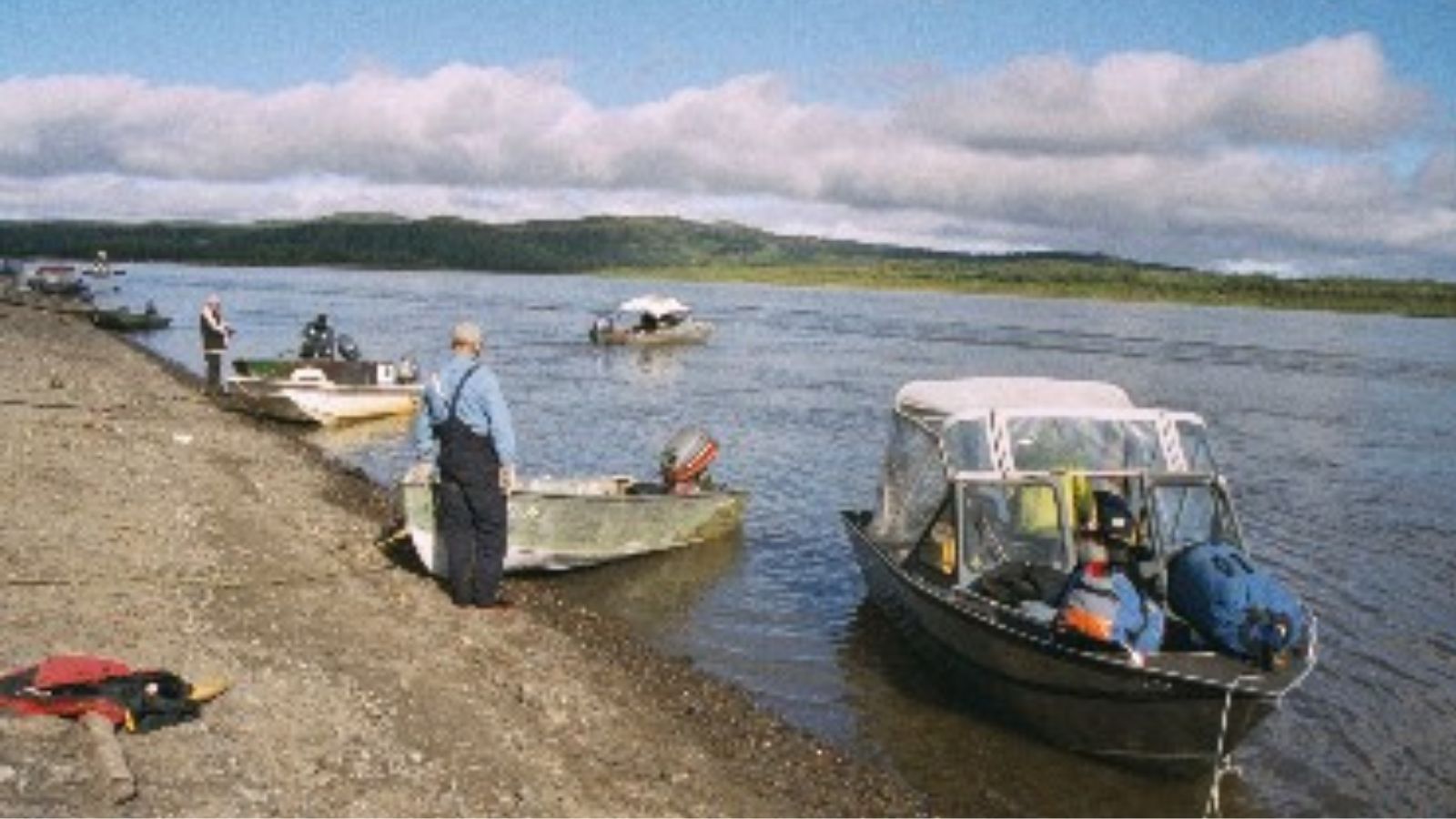
Located along the Kuskokwim River, Aniak and Lower Kalskag are small villages deep in rural Alaska. There are no roads connecting the area to the broader state network, and residents rely heavily on air or river transport. For seniors, that means minimal access to healthcare, no pharmacies, and few if any entertainment or wellness services.
Winters are especially harsh here, and infrastructure for aging adults is extremely limited. The area may appeal to subsistence lifestyles or longtime locals, but it lacks the kind of support systems retirees generally need to stay healthy, active, and socially connected.
Aniak – Lower Kalskag – ORS 27.21
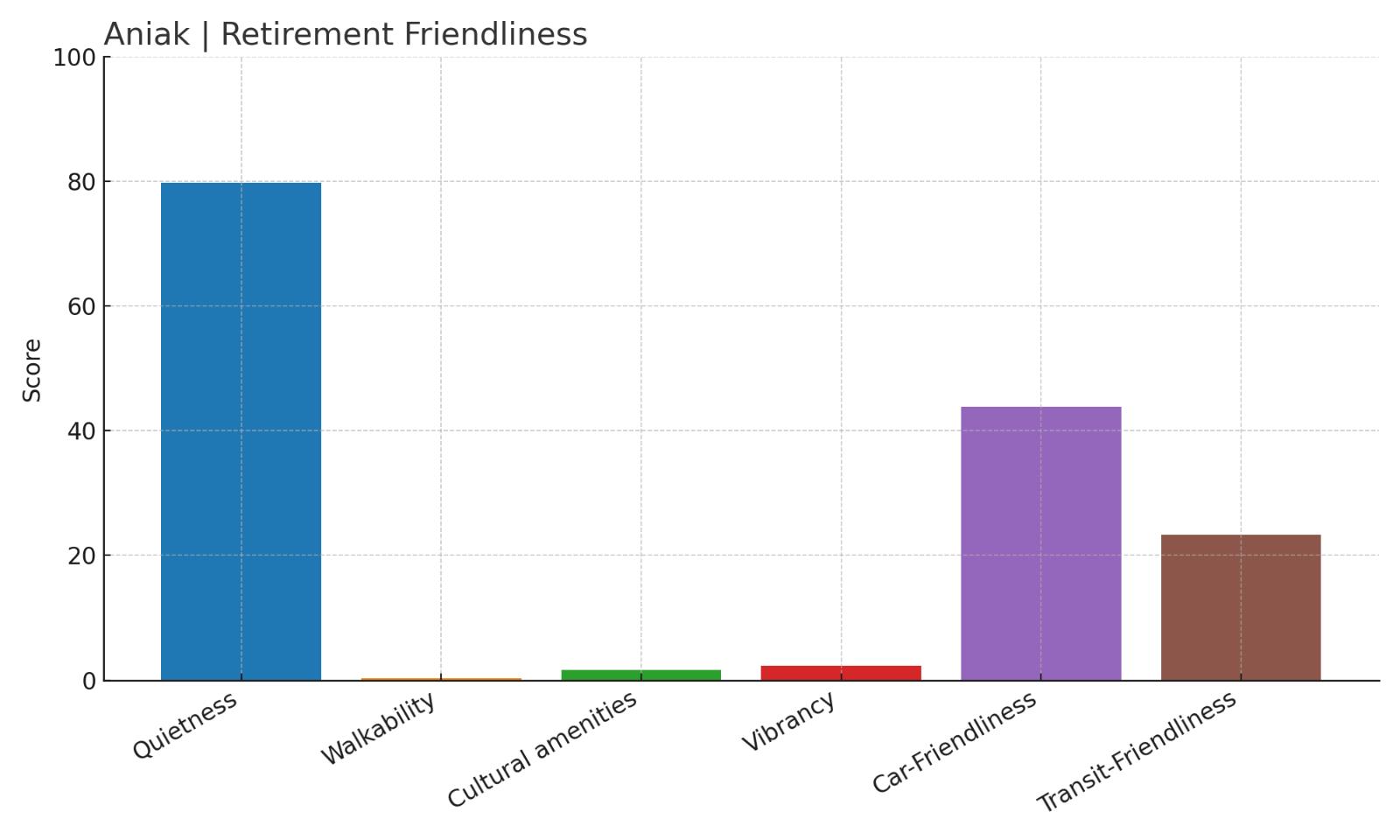
- Overall Retirement Score: 27.21
- Quietness: 79.71
- Walkability: 0.32
- Cultural amenities: 1.64
- Vibrancy: 2.3
- Car-Friendliness: 43.88
- Transit-Friendliness: 23.35
Aniak and Lower Kalskag are quiet but nearly unserviceable for retirees. With no walkable zones and barely any cultural or social offerings, aging in place here would be a challenge even for the most resilient senior.
7. Galena – Huslia – Not Equipped for Senior Living
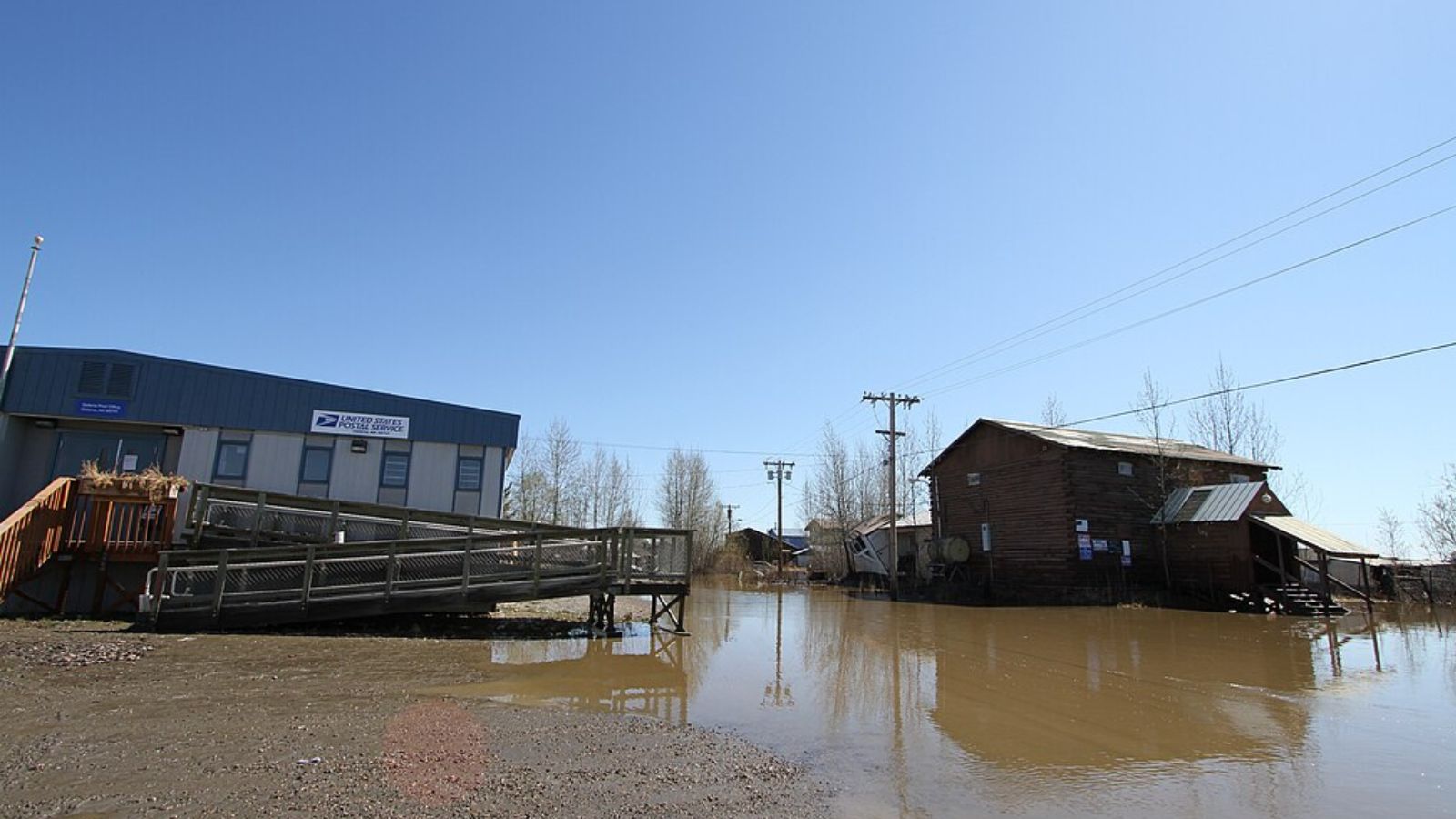
Galena and Huslia lie in Alaska’s interior, hundreds of miles from the nearest urban center. These villages are small, remote, and offer few amenities beyond basic schooling and general stores. While residents enjoy strong community ties, retirees without local connections may find themselves isolated and unsupported.
Healthcare is minimal and typically requires air transport to Fairbanks or Anchorage. Combine that with no walkable infrastructure, nonexistent public transit, and very few cultural outlets, and the region quickly becomes unsuitable for aging adults seeking even modest services or stimulation.
Galena – Huslia – ORS 26.90
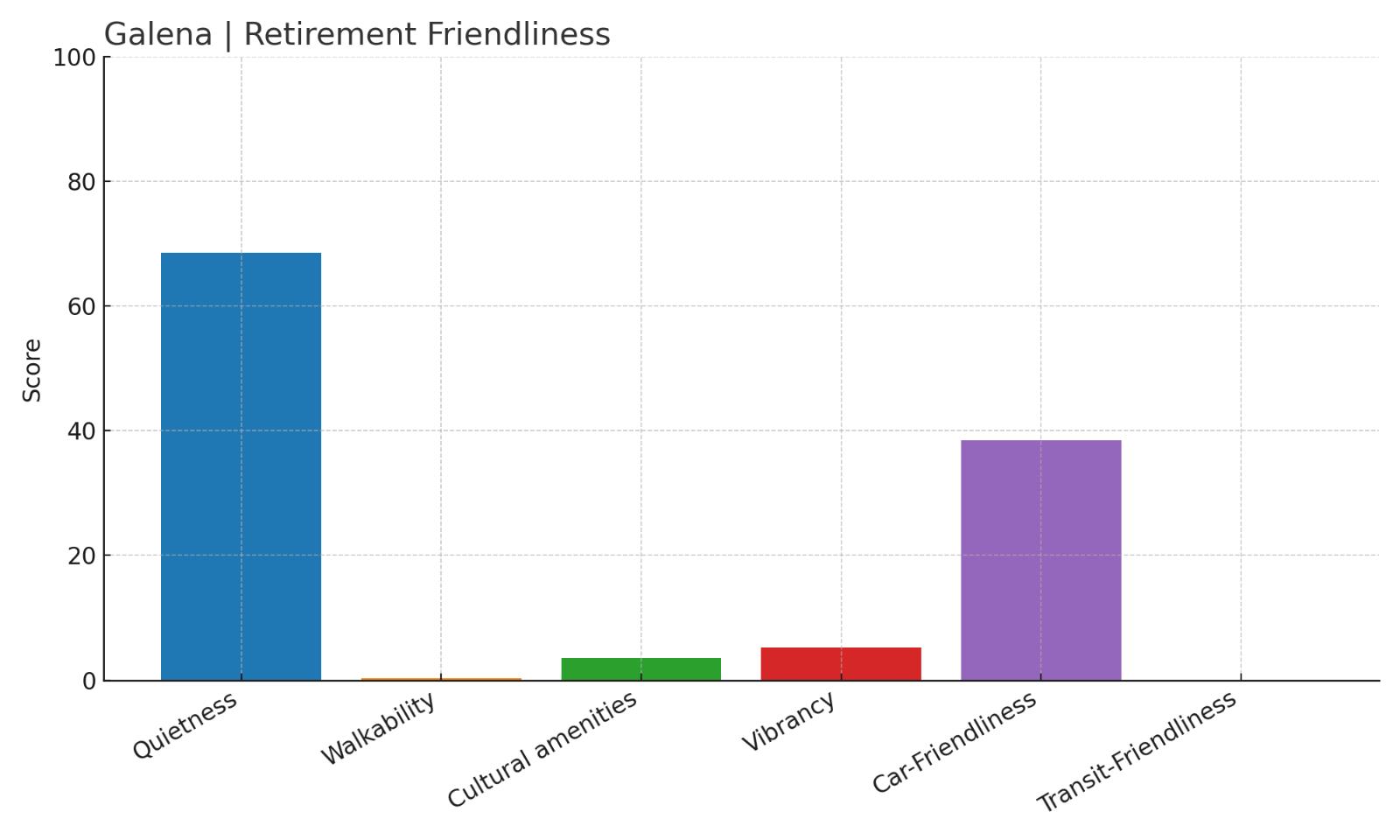
- Overall Retirement Score: 26.9
- Quietness: 68.53
- Walkability: 0.31
- Cultural amenities: 3.58
- Vibrancy: 5.19
- Car-Friendliness: 38.44
- Transit-Friendliness: 0
These towns rank poorly across nearly every retirement factor. While Galena and Huslia are quiet and car-friendly enough for short trips, the absence of transit and walkable services is a serious drawback for seniors.
6. McGrath – Holy Cross – Few Services, Fewer Options
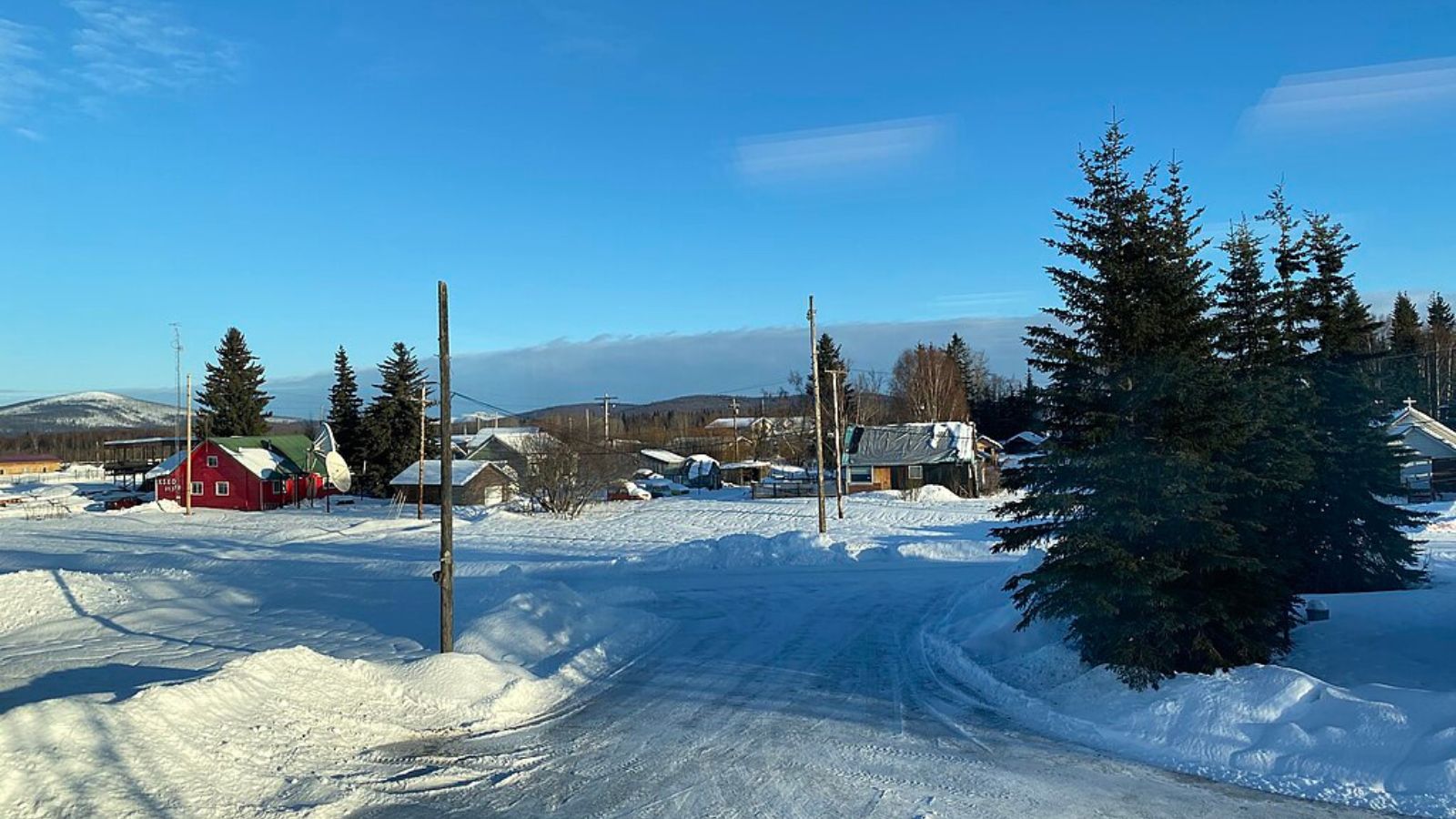
McGrath and Holy Cross are tiny communities scattered along rivers in Alaska’s interior. Their remoteness is matched only by their minimal infrastructure—very limited medical care, no public transport, and virtually zero walkable spaces. These villages were not built with retirement in mind, and it shows.
Even basic errands require effort, often involving costly travel arrangements or long waits for goods. Seniors here must be extremely self-sufficient, and without close family support or a deep connection to the community, life can be tough and isolating.
McGrath – Holy Cross – ORS 26.51

- Overall Retirement Score: 26.51
- Quietness: 83.77
- Walkability: 1.39
- Cultural amenities: 3.3
- Vibrancy: 2.07
- Car-Friendliness: 13.8
- Transit-Friendliness: 0
Quiet and rural, McGrath and Holy Cross lack everything from reliable car infrastructure to social vibrancy. The few cultural offerings aren’t enough to outweigh the daily difficulties retirees would face here, especially with no transit or support services.
5. Point Hope – Wainwright – Arctic Isolation
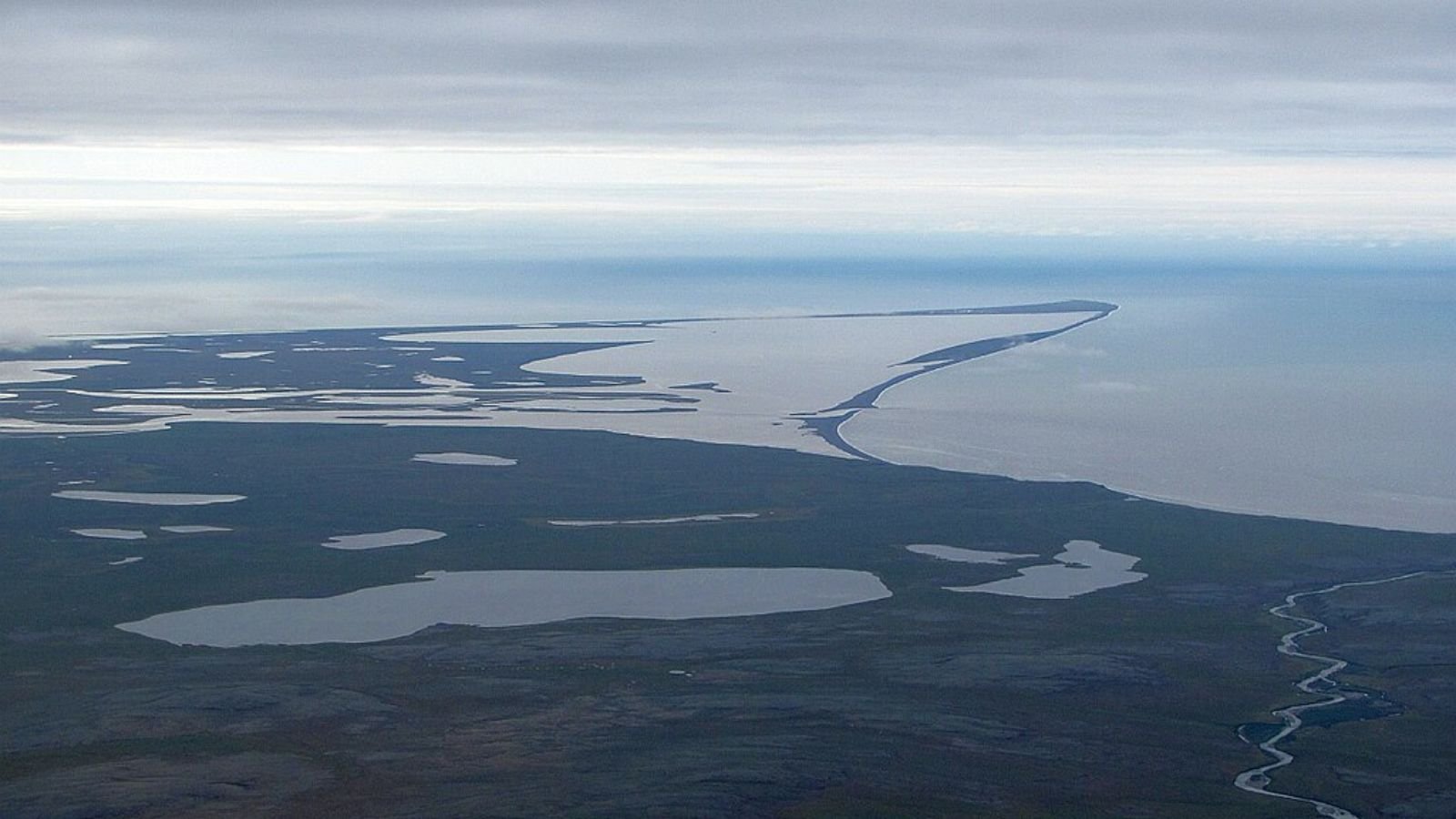
Located on the coast of the Chukchi Sea, both Point Hope and Wainwright are Arctic communities accessible only by air. Winters are long and brutally cold, and infrastructure is focused more on subsistence and survival than comfort or senior services.
There are few paved roads, no public transportation, and a lack of medical specialists. Retirees would need to travel for nearly every major service. While these towns have rich Indigenous culture and strong traditions, they offer little in the way of ease or convenience for aging adults.
Point Hope – Wainwright – ORS 26.46
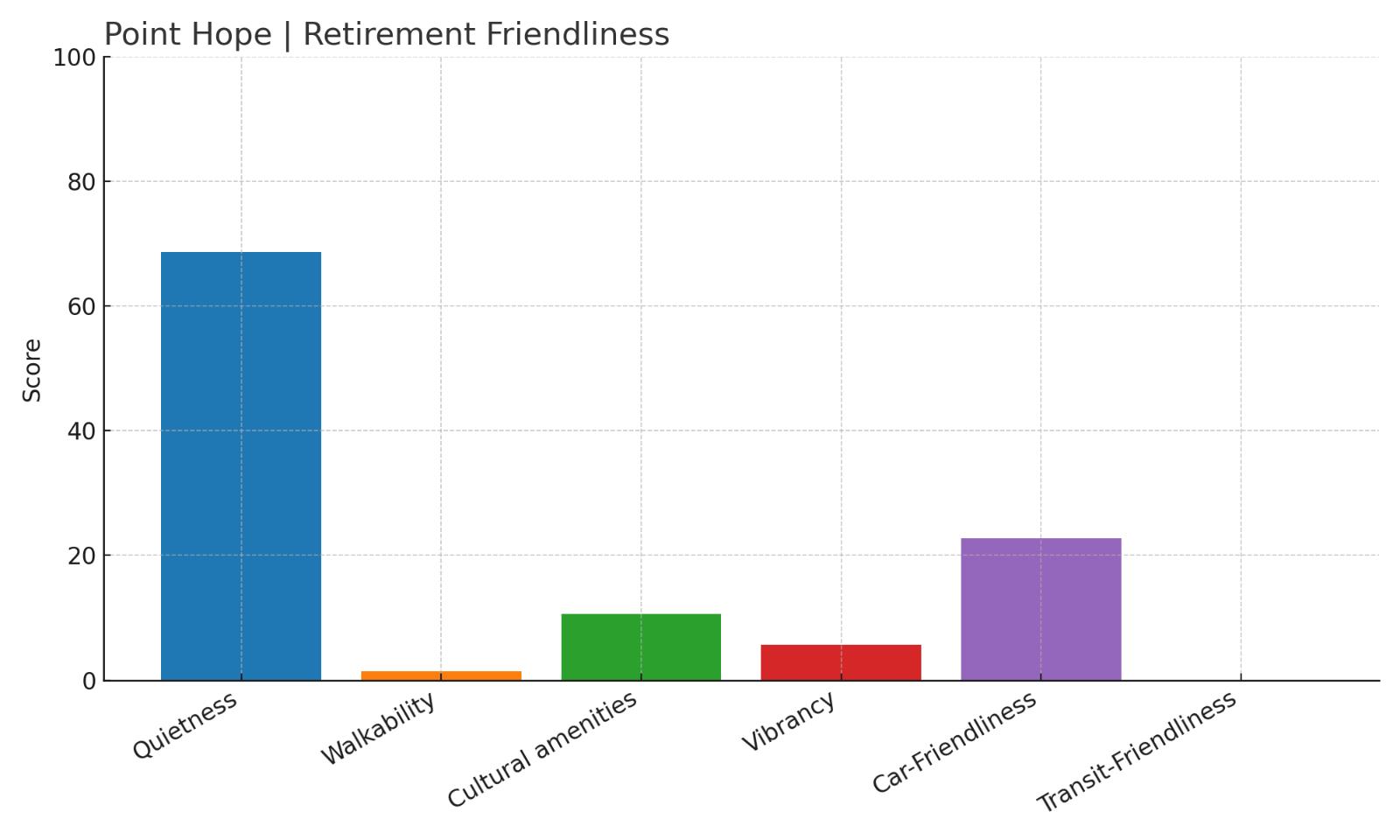
- Overall Retirement Score: 26.46
- Quietness: 68.7
- Walkability: 1.47
- Cultural amenities: 10.58
- Vibrancy: 5.64
- Car-Friendliness: 22.7
- Transit-Friendliness: 0
These towns rank better than some others on cultural amenities, but they still fall far short on infrastructure retirees need. The mix of Arctic isolation, limited walkability, and no transit puts them among the least suitable towns in Alaska for retirement.
4. Utqiagvik – Harsh Climate and Minimal Access

Utqiagvik, formerly known as Barrow, is the northernmost town in the United States. It’s known for its unique culture and location above the Arctic Circle—but those same traits also make it one of the least practical places for retirees. With temperatures plunging well below zero for much of the year and limited daylight in winter, even basic errands can be physically taxing.
There are no roads connecting Utqiagvik to the rest of Alaska, and everything from fresh produce to medical care comes in by plane. It’s a remarkable place to visit or live for those with strong local ties, but it lacks the daily conveniences, healthcare access, and mobility options that most retirees require.
Utqiagvik – ORS 25.74
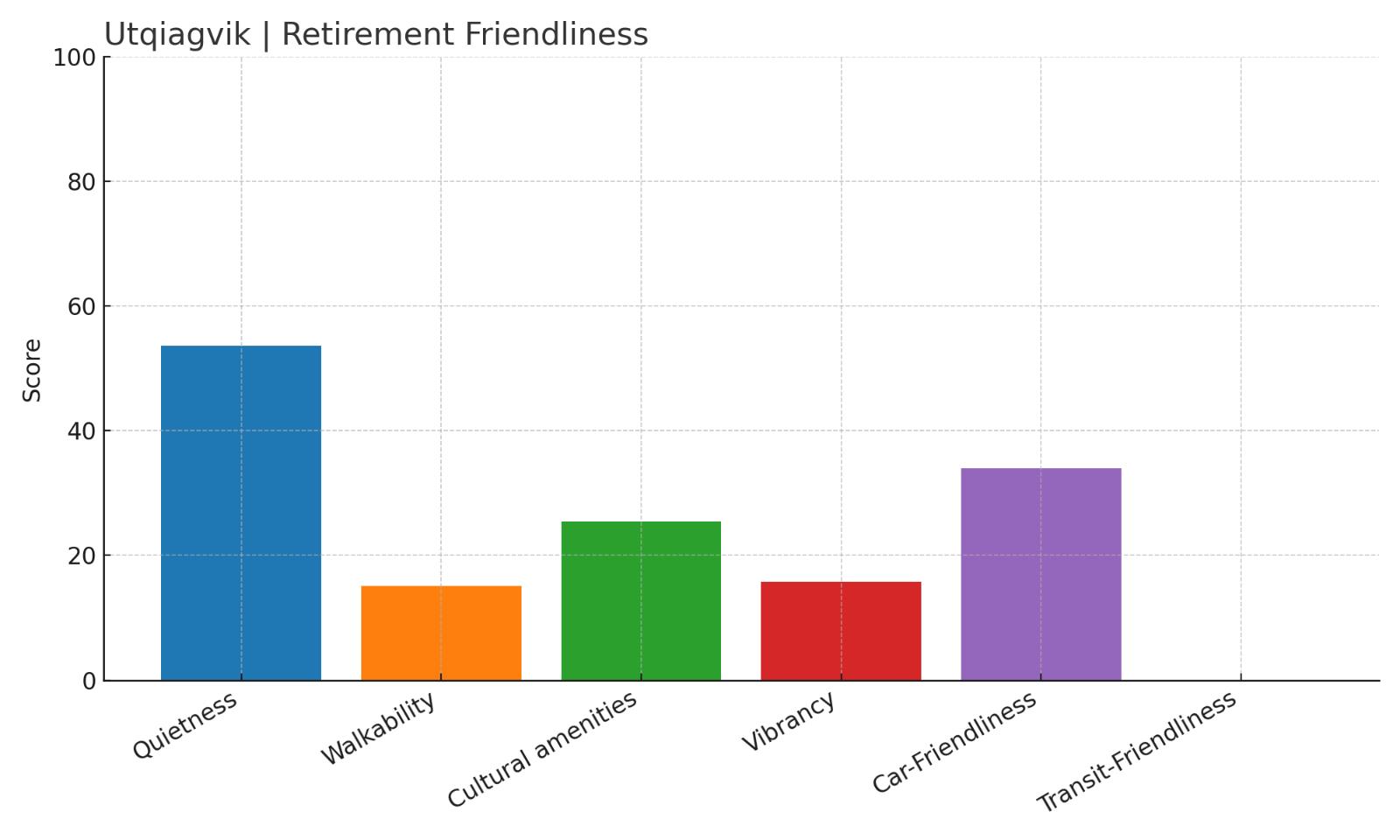
- Overall Retirement Score: 25.74
- Quietness: 53.65
- Walkability: 15.15
- Cultural amenities: 25.43
- Vibrancy: 15.75
- Car-Friendliness: 33.94
- Transit-Friendliness: 0
Utqiagvik ranks low across several key retirement categories, especially transit and car-friendliness. While it offers modest cultural value, the climate, extreme isolation, and lack of senior-friendly infrastructure push it far down the list for retirees.
3. Eielson Air Force Base – Temporary and Inaccessible
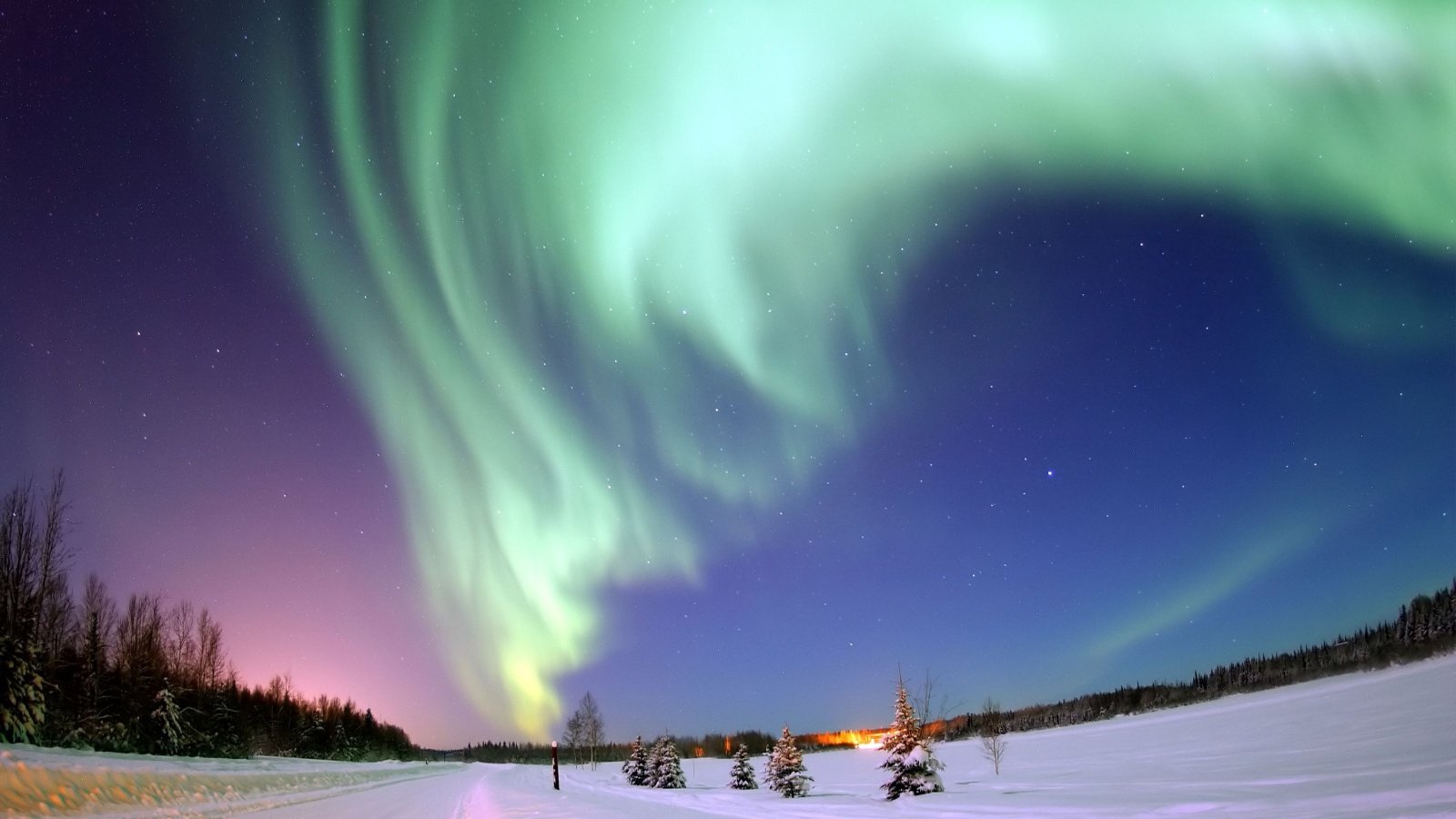
Eielson Air Force Base isn’t a civilian retirement destination in any meaningful sense. Located southeast of Fairbanks, it primarily serves active-duty military personnel and their families. Most of the amenities and services are geared toward younger residents with base access—and retirees may find themselves excluded from many aspects of daily life.
The area lacks walkability and has no public transportation available. Unless you have a specific connection to the base, there’s little reason to consider Eielson for retirement. Even quiet areas nearby are offset by the lack of community integration for non-military seniors.
Eielson Air Force Base – ORS 22.03

- Overall Retirement Score: 22.03
- Quietness: 34.98
- Walkability: 0.57
- Cultural amenities: 9.32
- Vibrancy: 9.25
- Car-Friendliness: 75.57
- Transit-Friendliness: 0
Despite being highly car-friendly, Eielson scores poorly across nearly every other retiree-friendly metric. Walkability is near zero, vibrancy and cultural opportunities are limited, and without access to base services, retirees may feel cut off from even basic routines.
2. Unalakleet – Beautiful But Lacking Basics
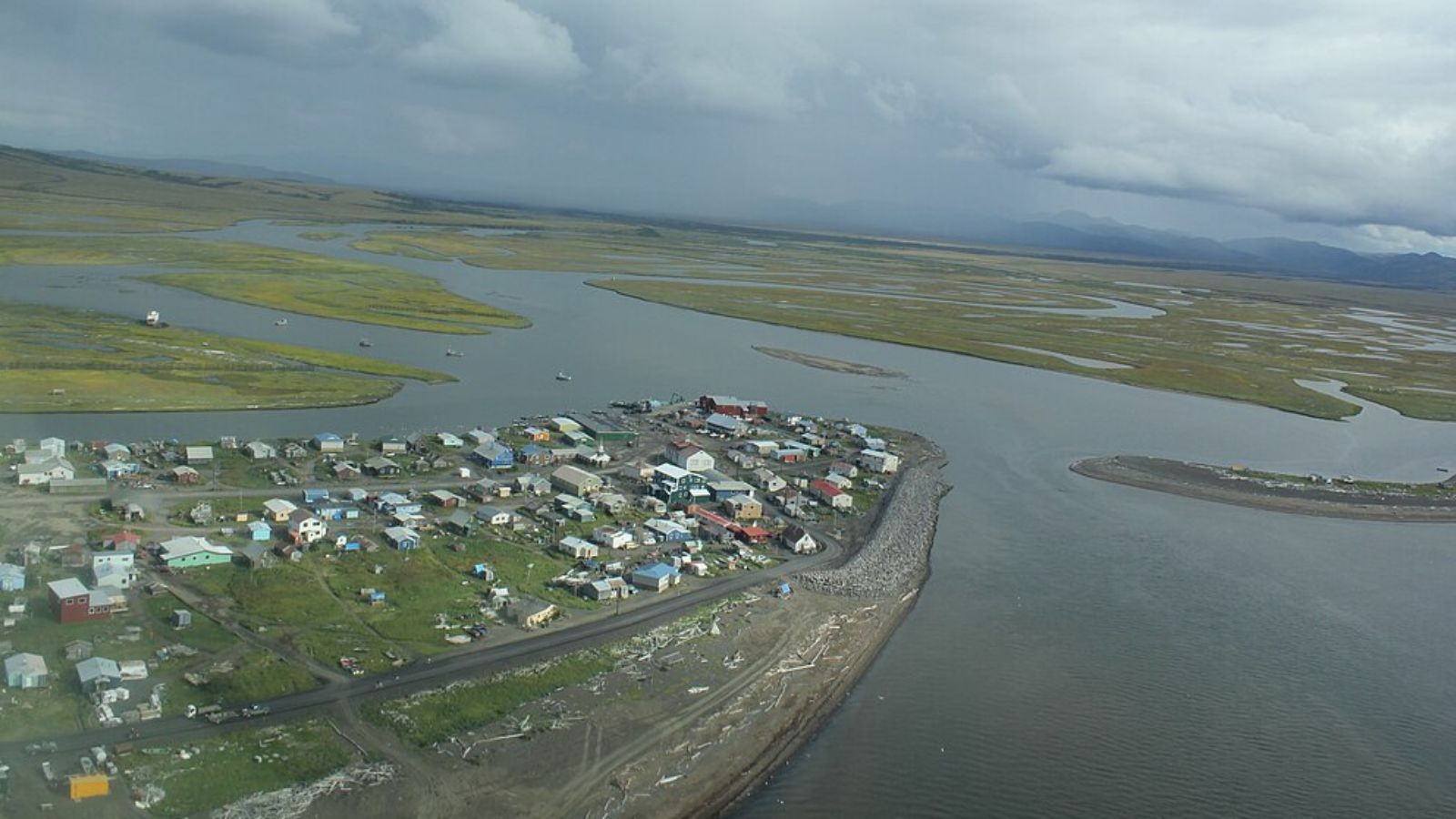
Unalakleet sits on Alaska’s western coast and offers stunning views of the Bering Sea. It’s a culturally rich community with a strong Indigenous presence, but it’s also remote, weather-beaten, and difficult to reach. There are no roads in or out—only air service—and amenities are limited to the essentials.
For retirees, the lack of healthcare access and mobility options makes day-to-day life challenging. It’s a beautiful place to grow up or visit, but not a location where seniors can comfortably and independently age in place. Winters are especially unforgiving for those with medical or mobility issues.
Unalakleet – ORS 21.35
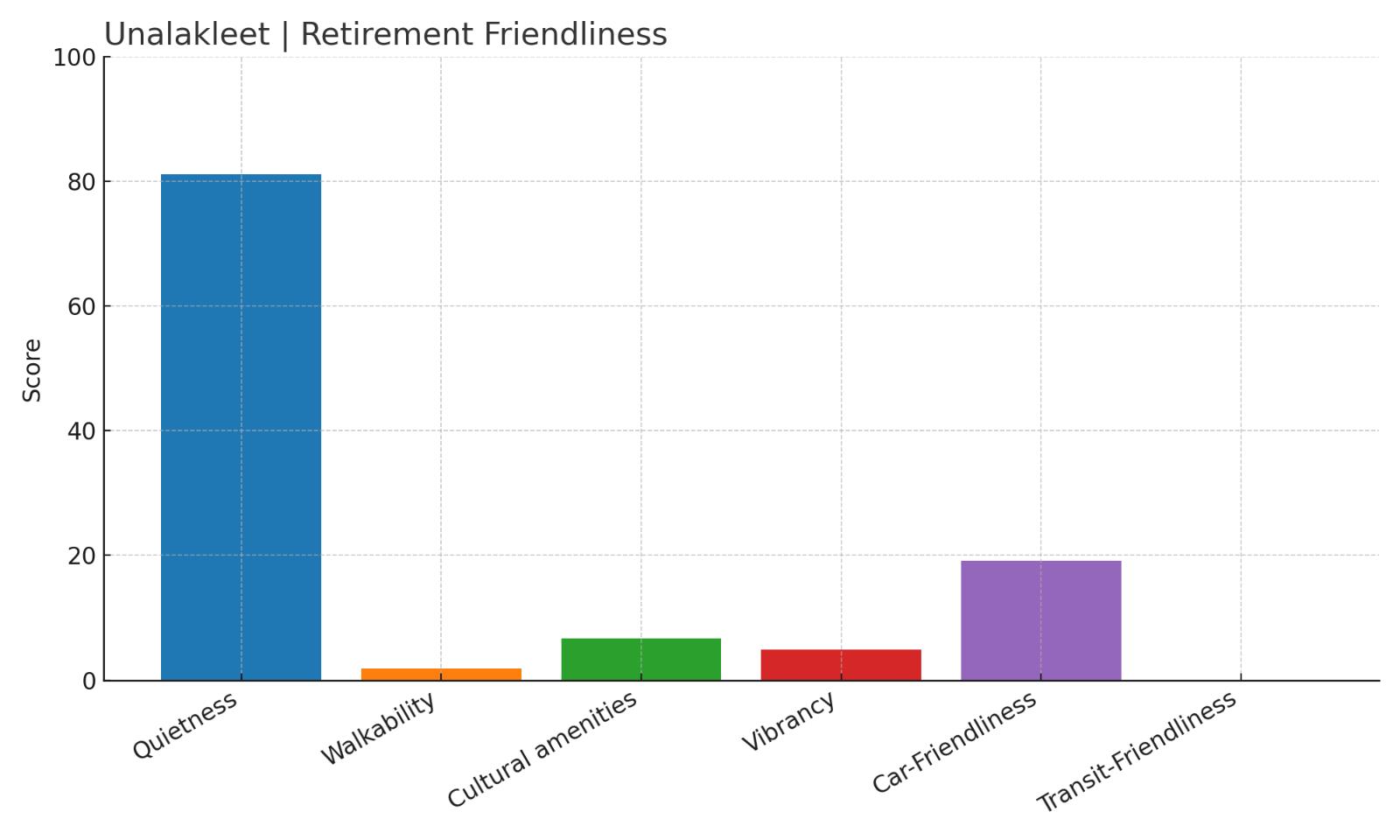
- Overall Retirement Score: 21.35
- Quietness: 81.11
- Walkability: 1.87
- Cultural amenities: 6.74
- Vibrancy: 4.85
- Car-Friendliness: 19.13
- Transit-Friendliness: 0
Unalakleet’s quiet atmosphere is appealing, but the low walkability, poor car infrastructure, and nonexistent transit make it one of the least accessible towns for retirees. There’s little to offset the challenges of remote living for aging adults.
1. Selawik – Noorvik – Alaska’s Least Retirement-Friendly Towns
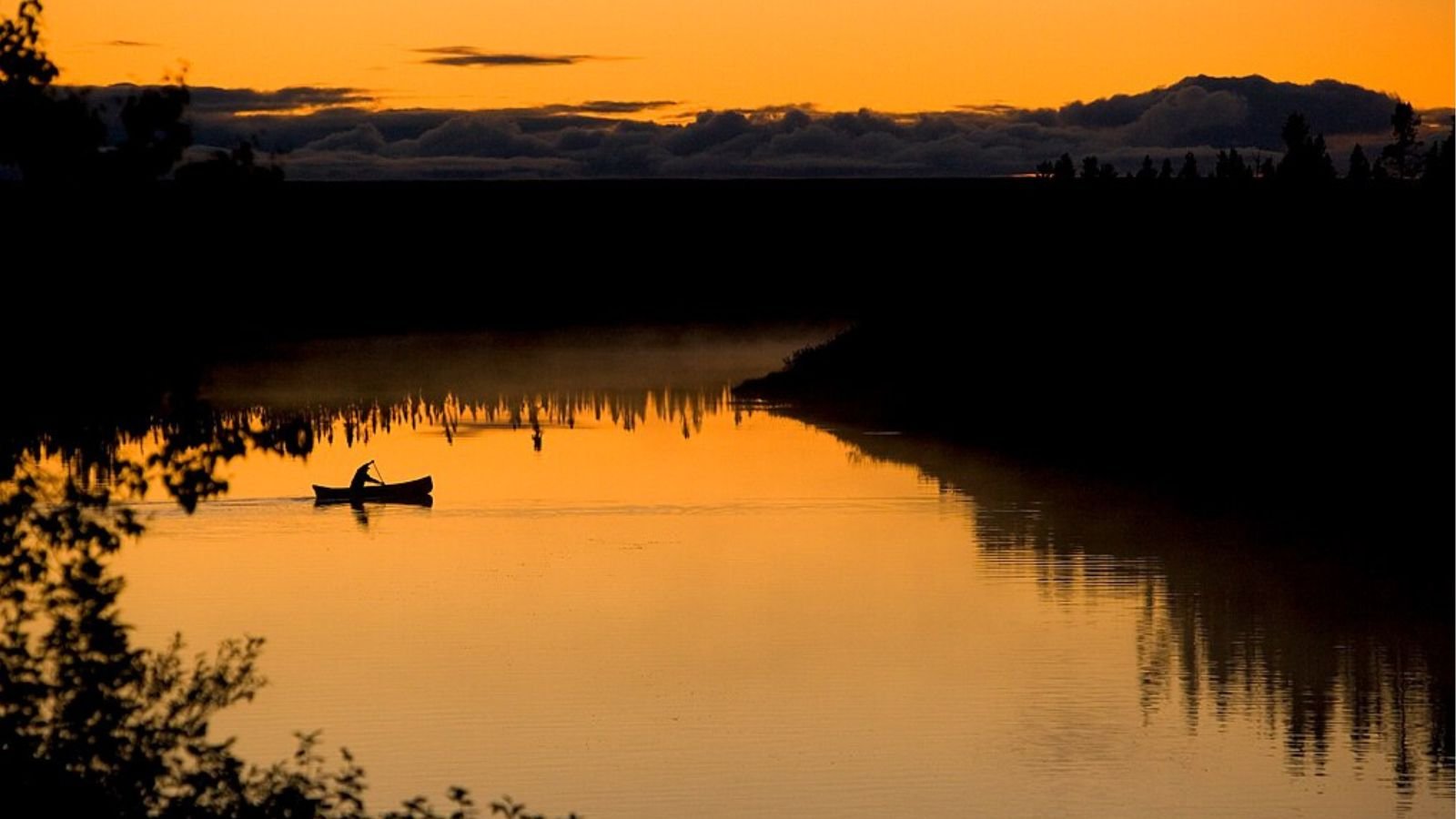
Selawik and Noorvik, located in Alaska’s northwest, round out this list with the lowest Overall Retirement Score in the state. These communities are fly-in only and sit far from any larger population center. Both towns lack paved roads, healthcare facilities, and public services tailored to older adults.
Residents rely heavily on subsistence lifestyles, and basic tasks like shopping or traveling for medical appointments require significant effort and coordination. For retirees without family ties or deep community roots, settling here would mean facing serious daily challenges in nearly every aspect of life.
Selawik – Noorvik – ORS 19.96
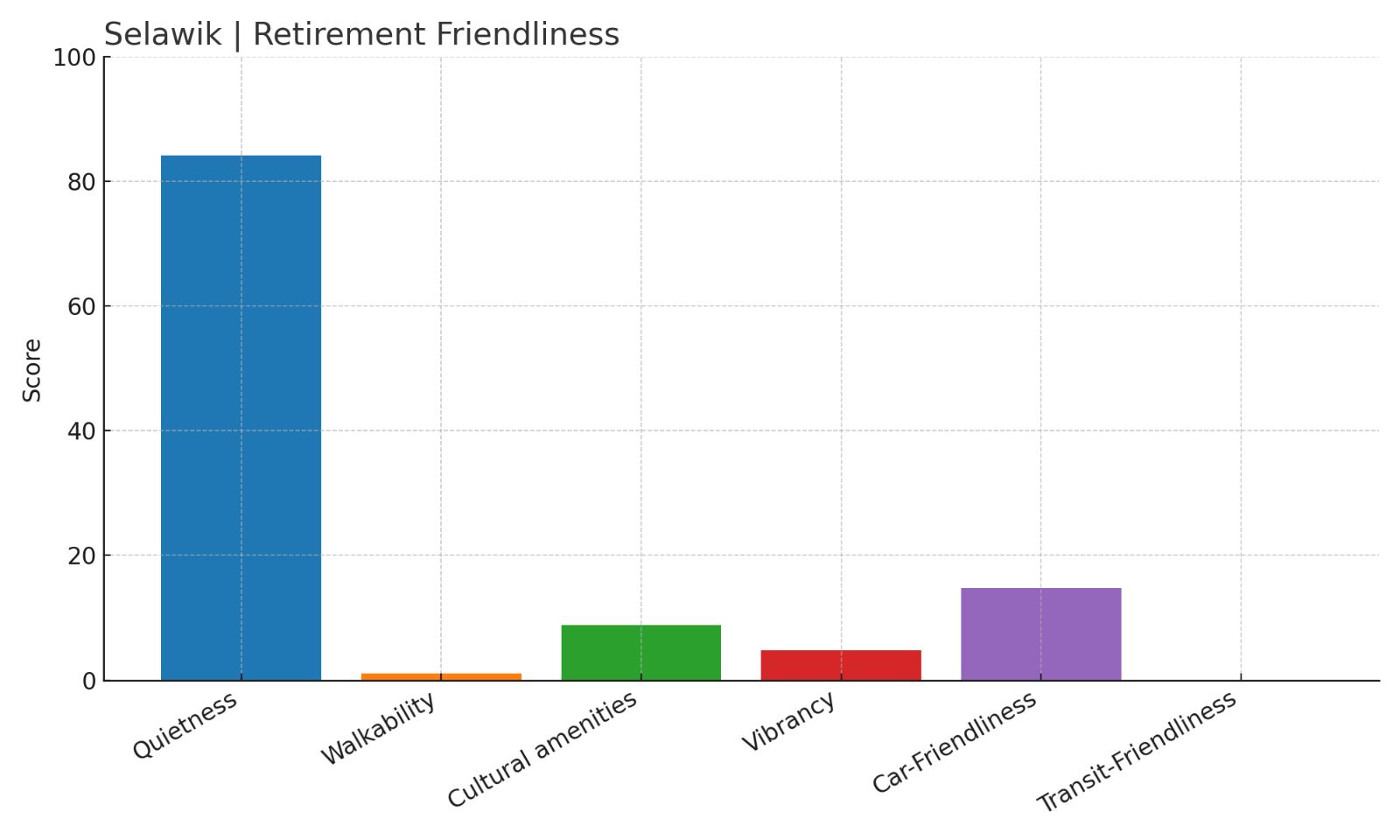
- Overall Retirement Score: 19.96
- Quietness: 84.09
- Walkability: 1.13
- Cultural amenities: 8.88
- Vibrancy: 4.8
- Car-Friendliness: 14.79
- Transit-Friendliness: 0
Selawik and Noorvik offer peace and natural beauty, but they fall short on nearly every metric that matters to retirees. With no walkable routes, poor vehicle infrastructure, and a complete absence of transit, the towns are simply not set up to support aging adults.






